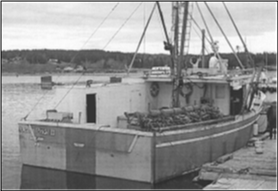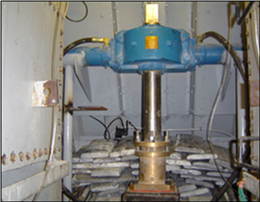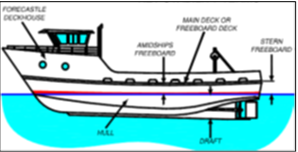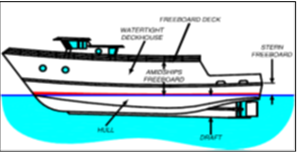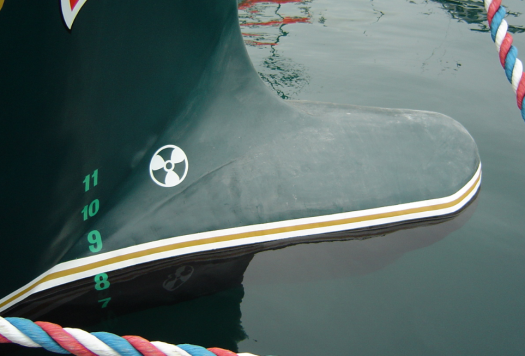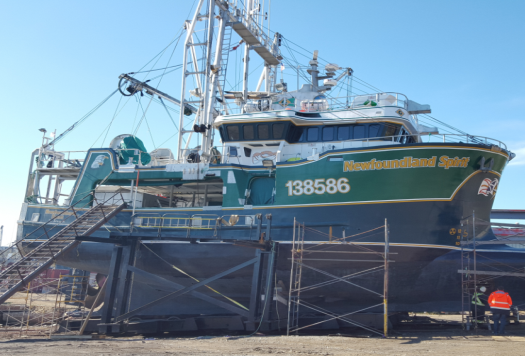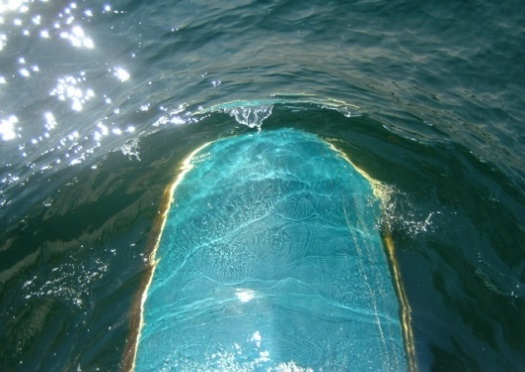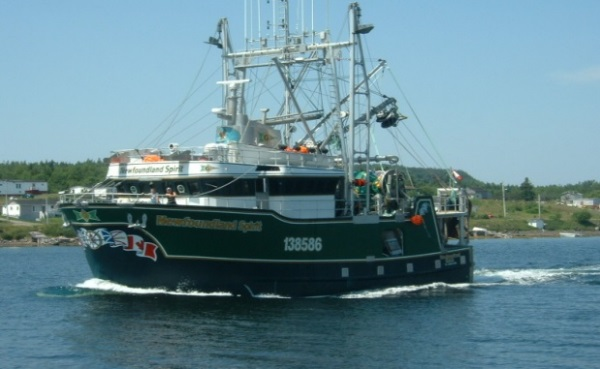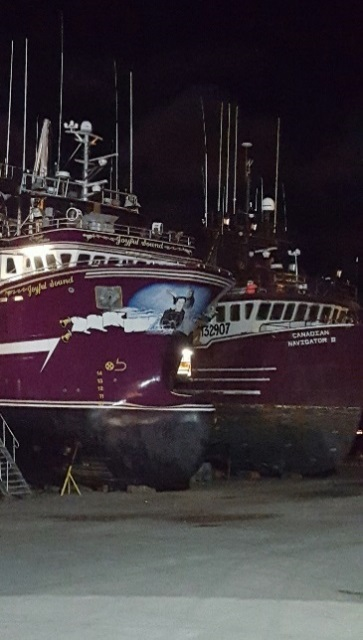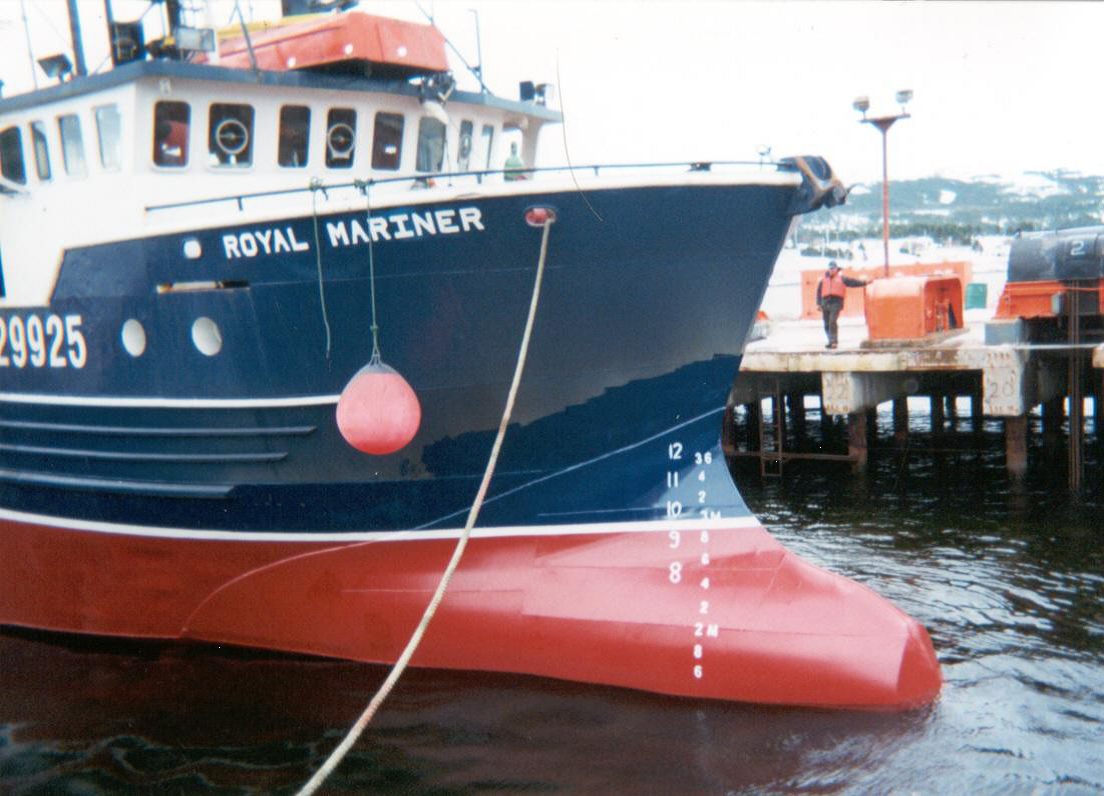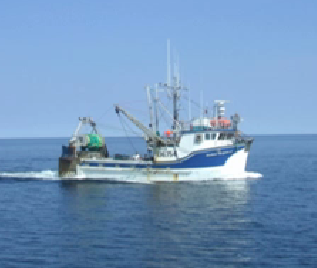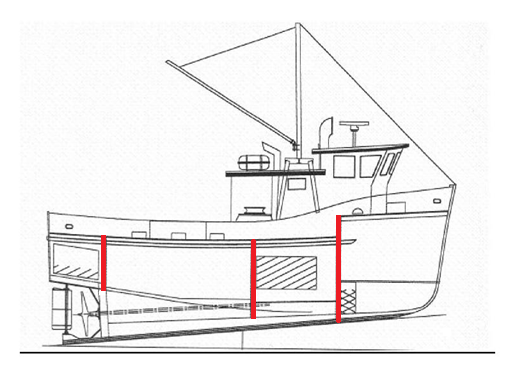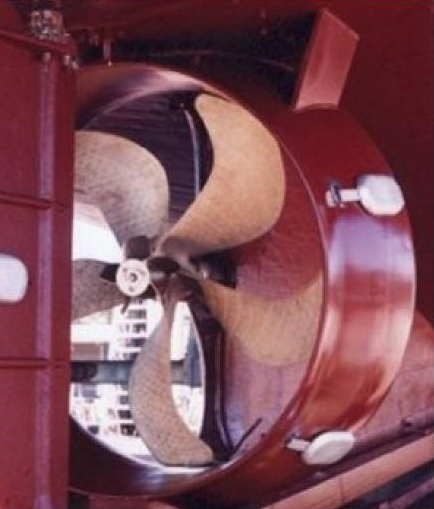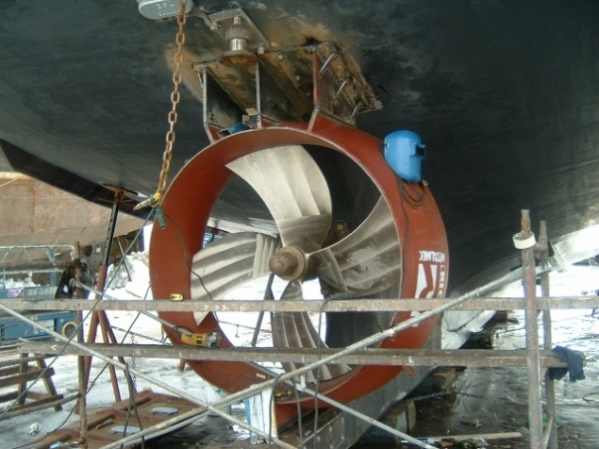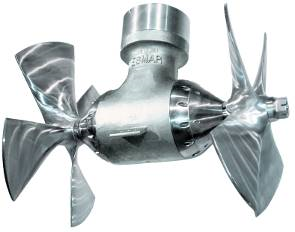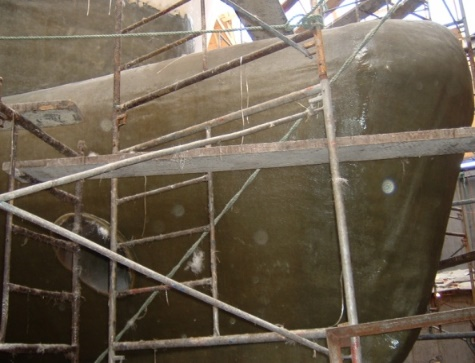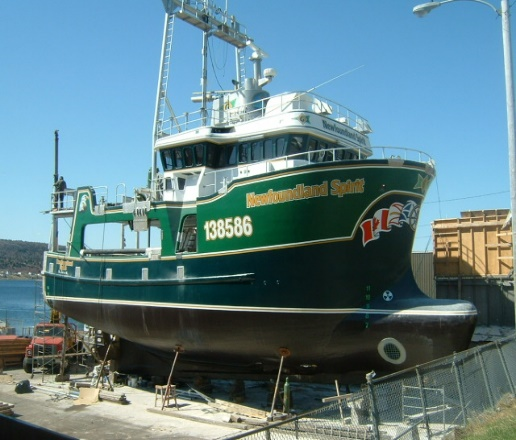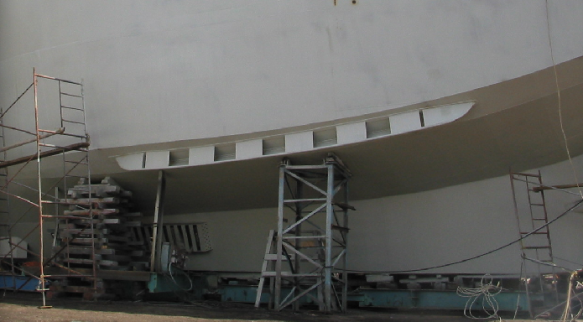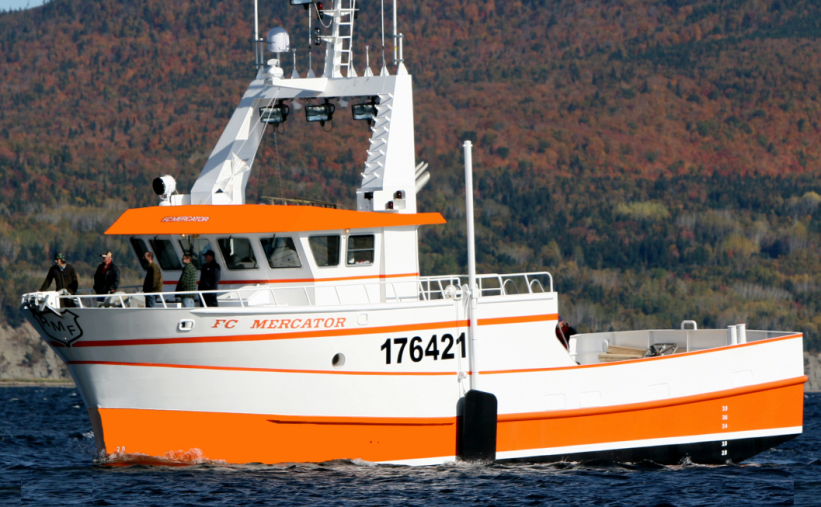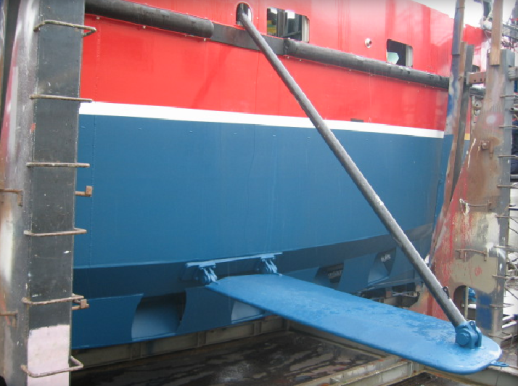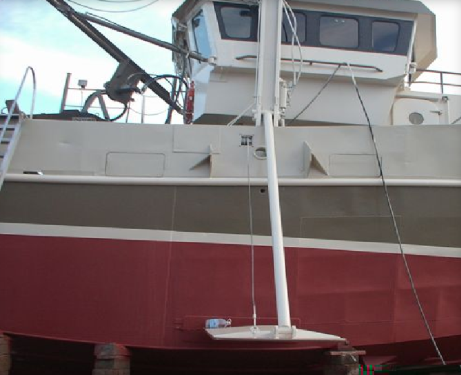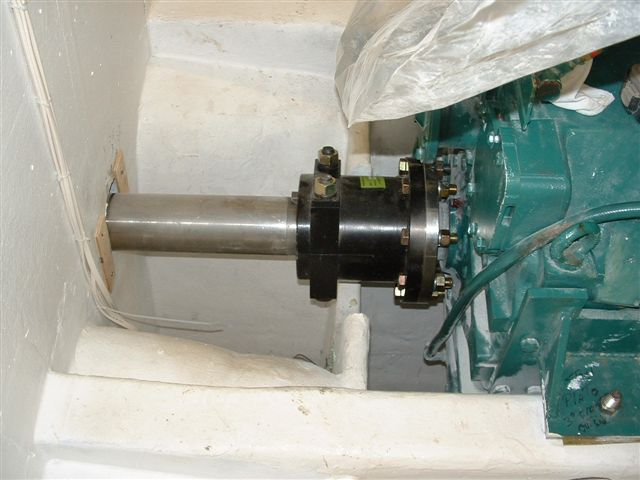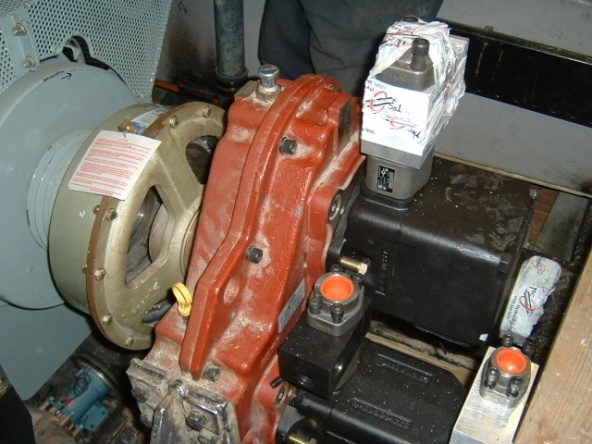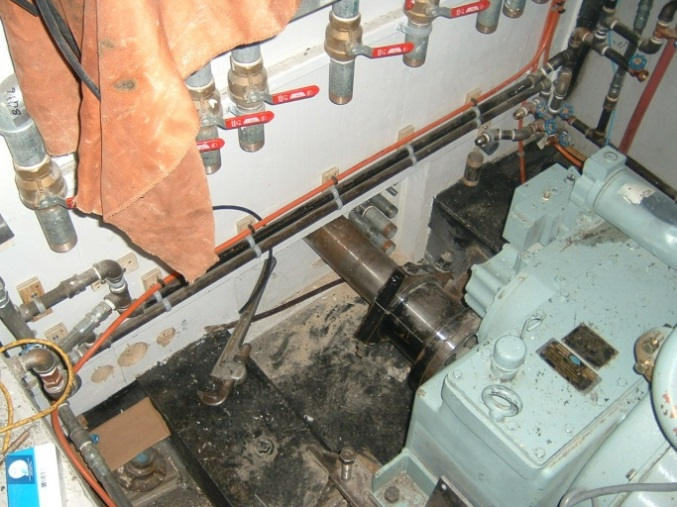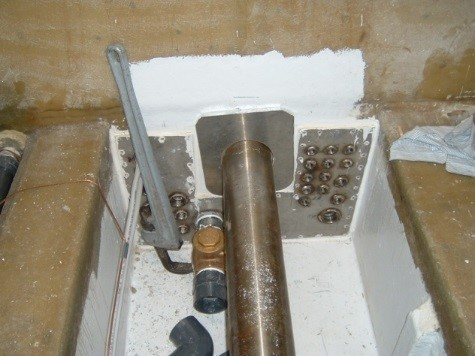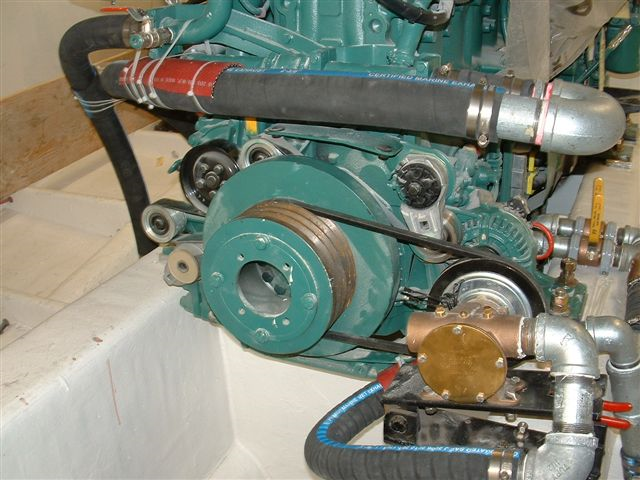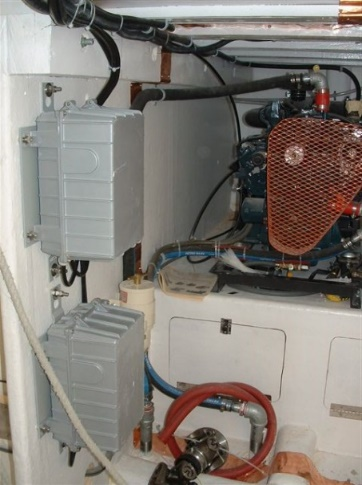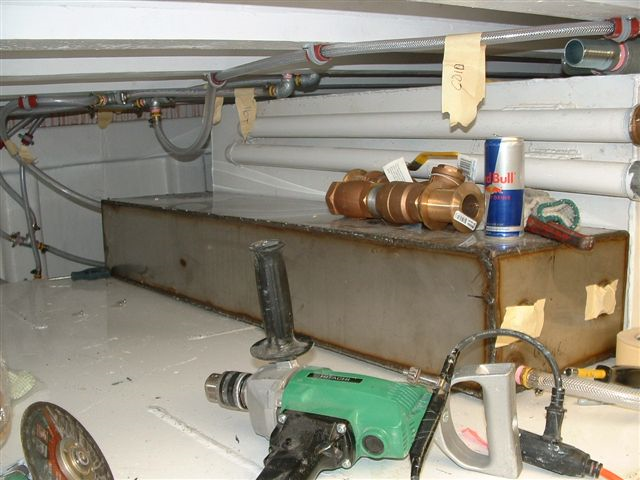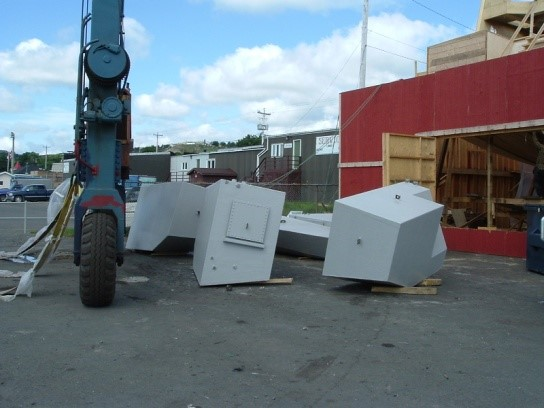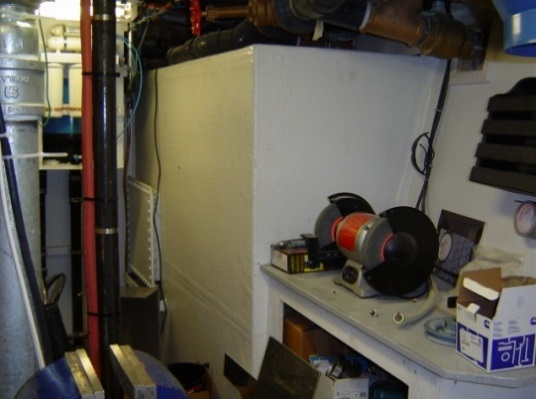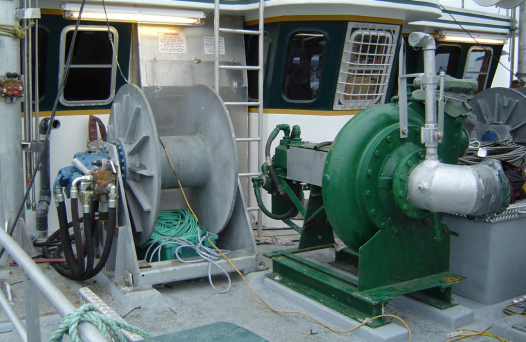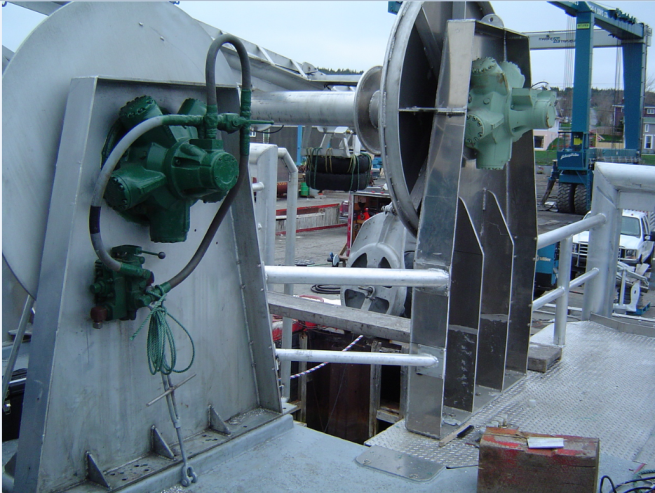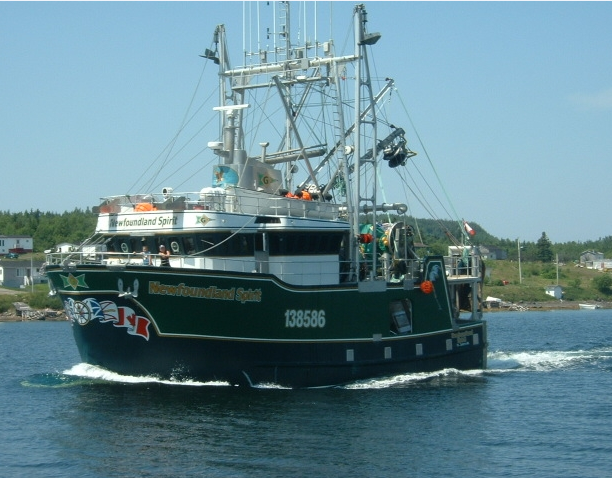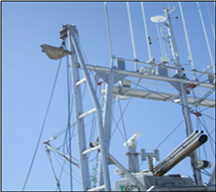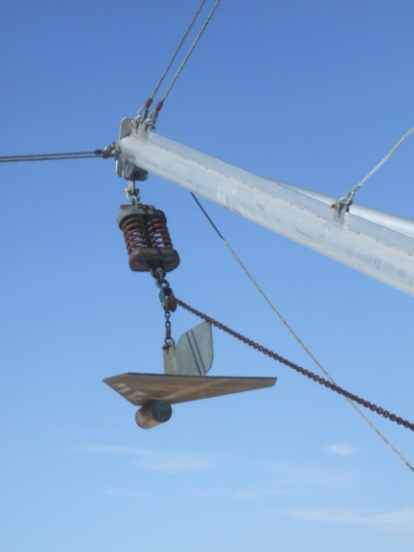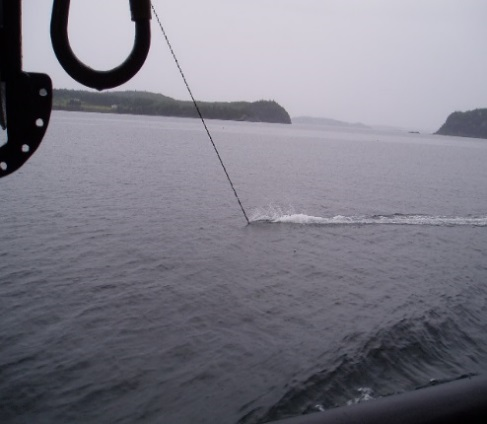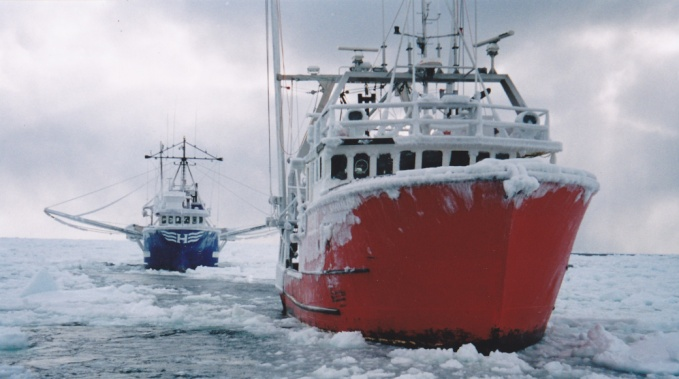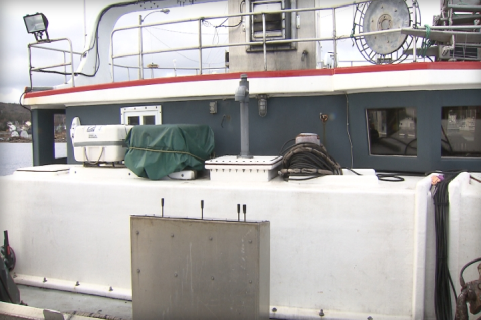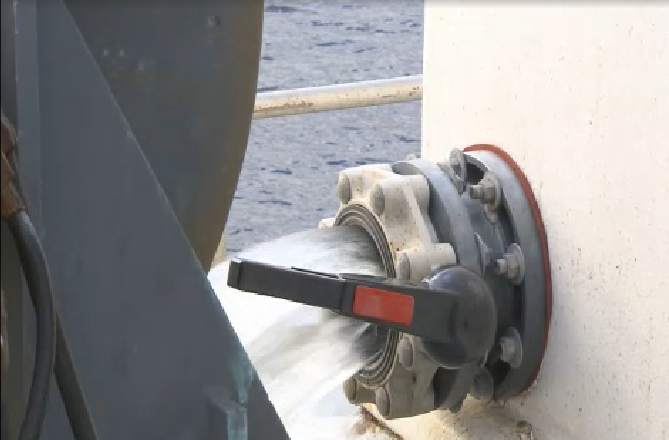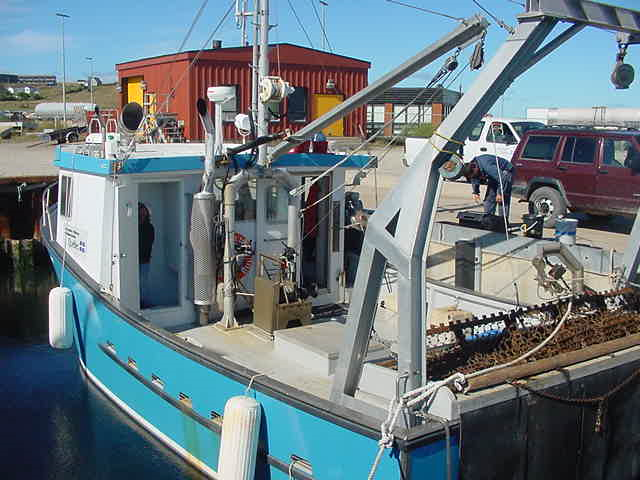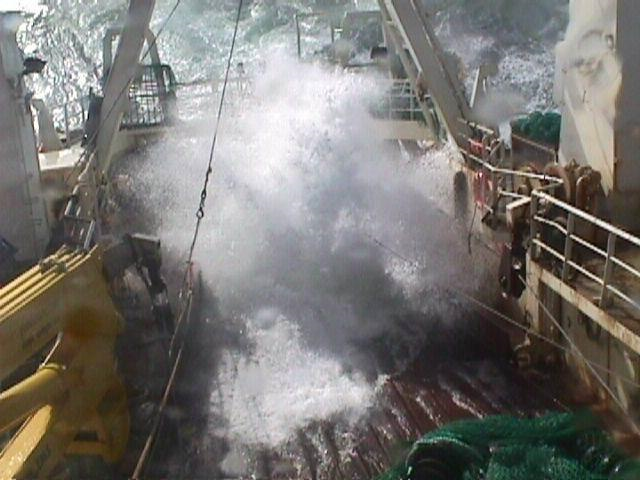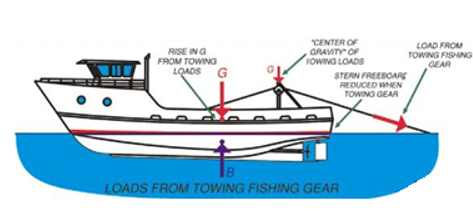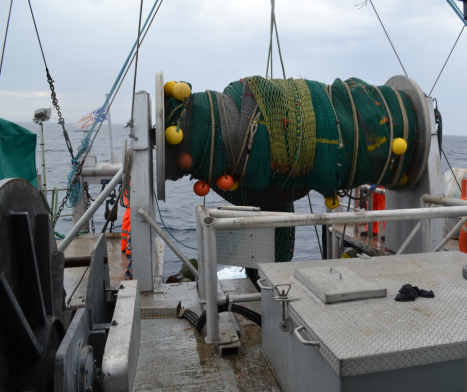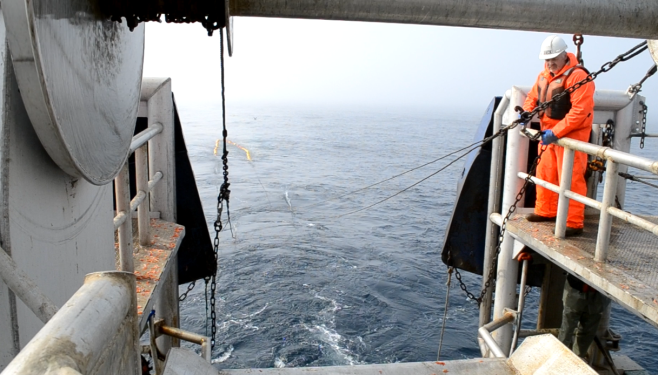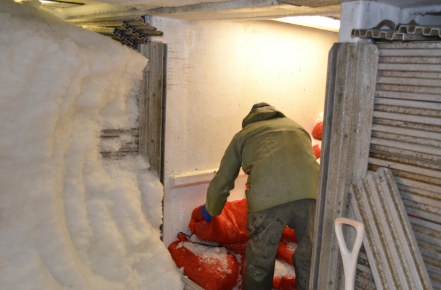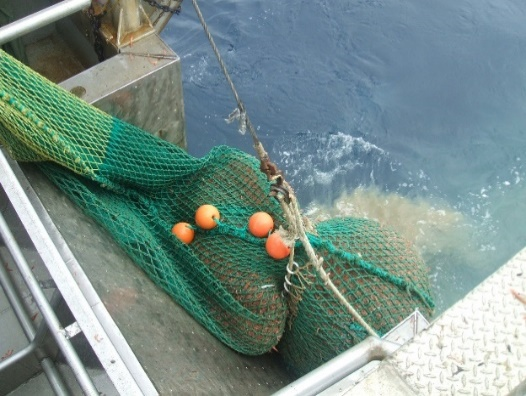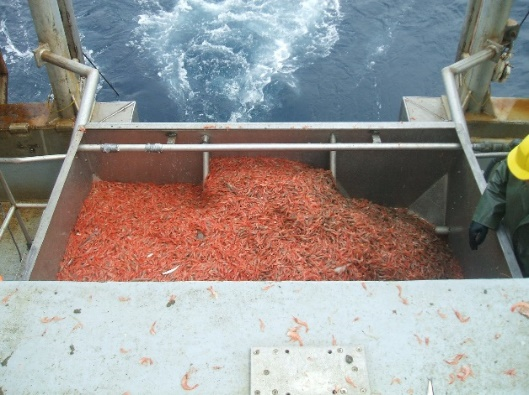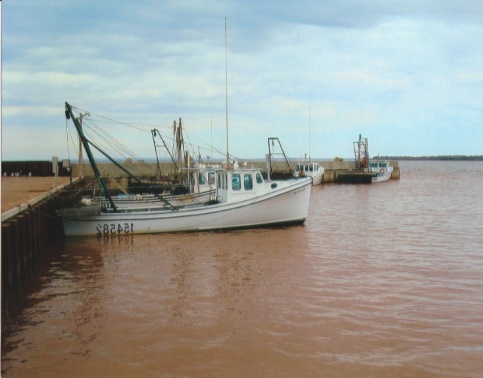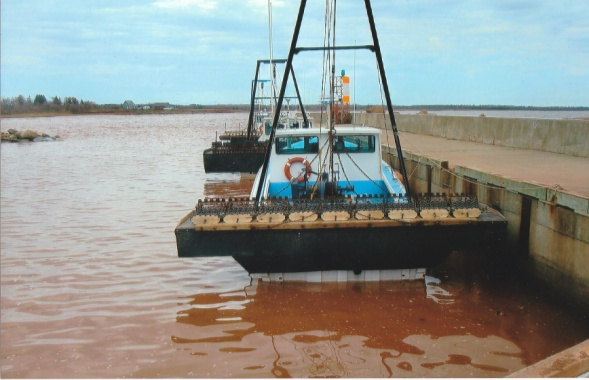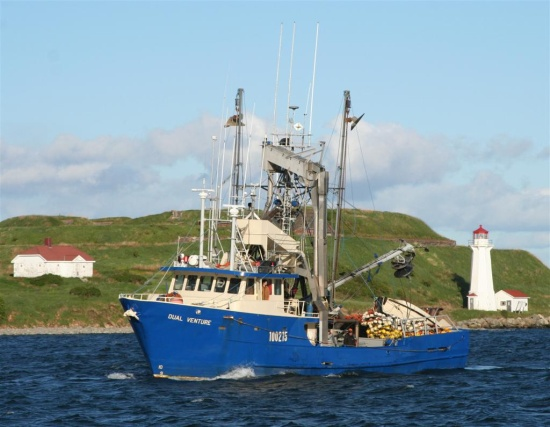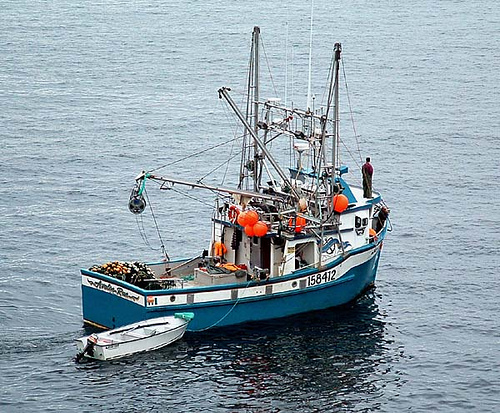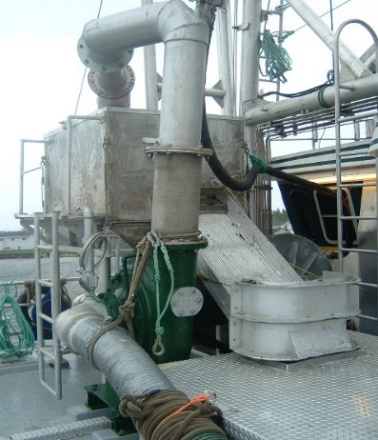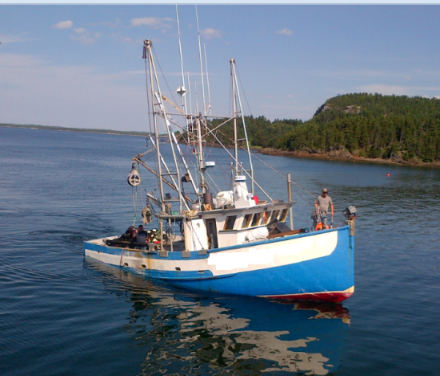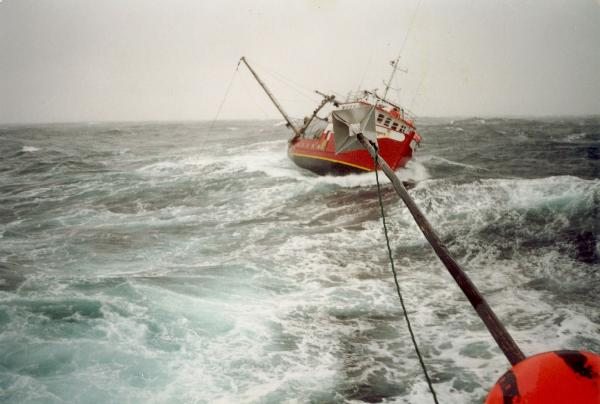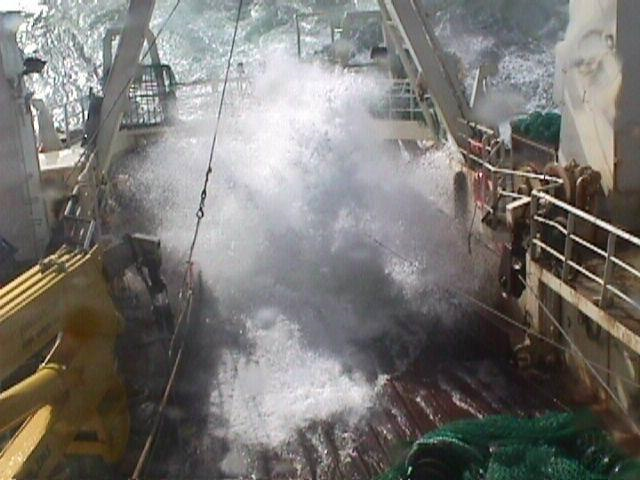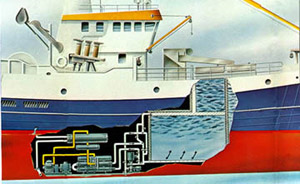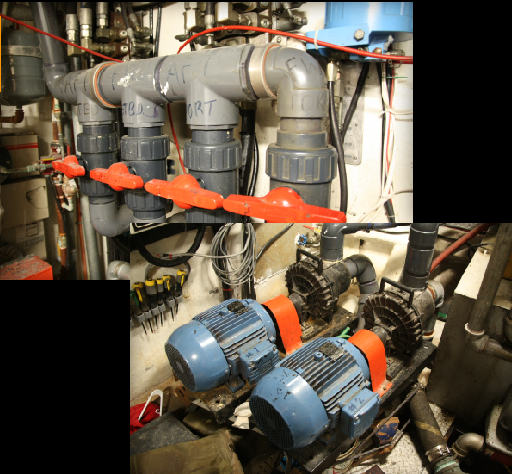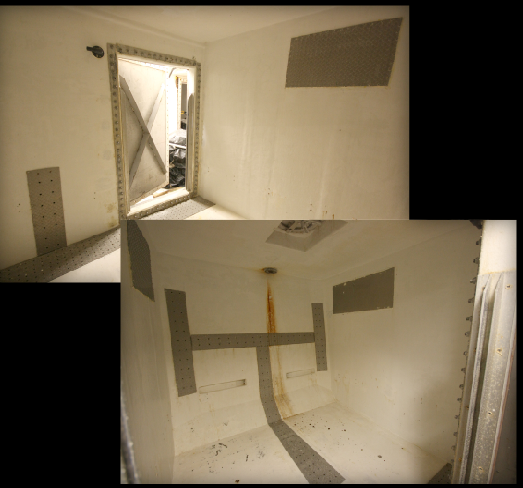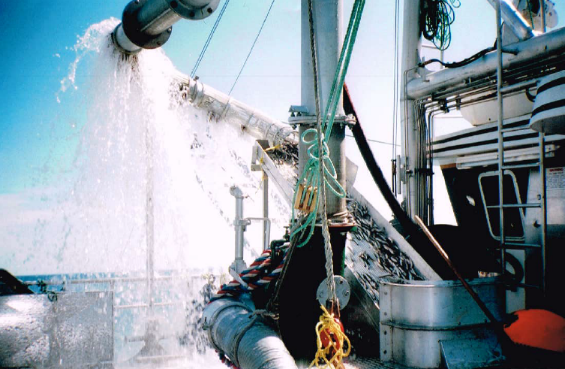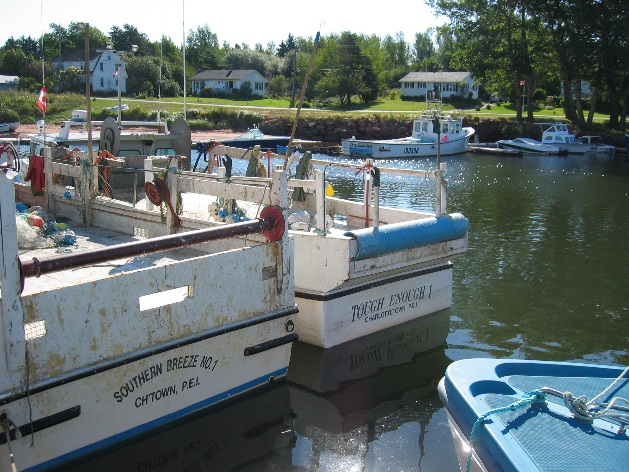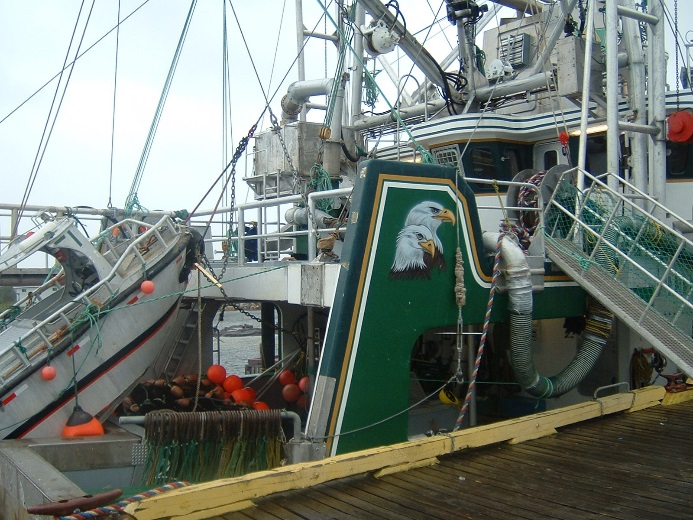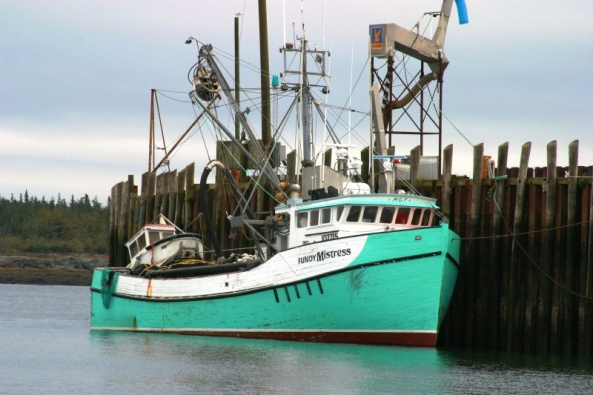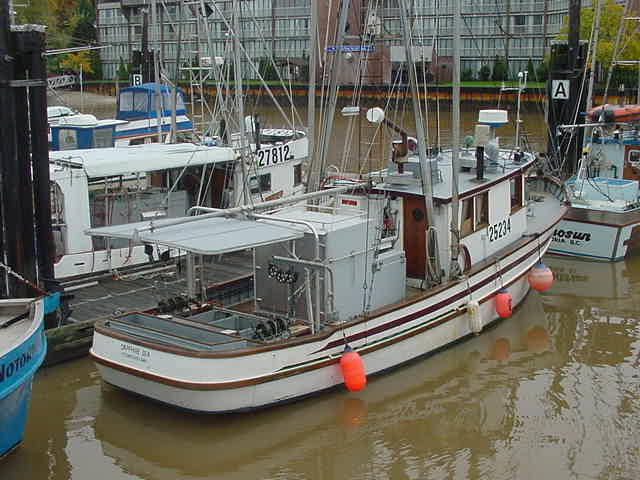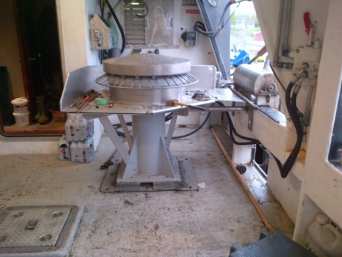The fishing vessel safety regulations came into force on July 13, 2017. The regulations contain new stability requirements. A vessel constructed on any date that has a hull length of more than 9 m, that has undergone a major modification or a change in activity that is likely to adversely affect its stability after July 13, 2017 or is fitted with an anti-roll tank, will be required to undergo a stability assessment by a competent person. The guidelines will help fishing vessel owners and operators understand how a major modification or change in activity can impact the stability of their vessel.
If you wish to receive a copy of the guidelines, please submit your request to the marine safety general email inbox at marinesafety-securitemaritime@tc.gc.ca.
On this page
- Acknowledgements
- Instructions on the use of this guide
- Fishing vessel modifications
- Change in activity
- Supporting stability information
- 1.0 Hull related
- 2.0 Superstructure and/or deckhouse
- 3.0 Below deck equipment and machinery
- 4.0 Above deck equipment and machinery
- 5.0 Change to a different type of fishing operation
- 6.0 Changes in the amount or type of fishing gear to be carried on board
- 7.0 Changes in the species to be harvested and/or on-board storage arrangement
- 8.0 Addition of temporary equipment
- Conclusion
Acknowledgements
These guidelines have been produced and developed jointly and under contract with the Canadian Independent Fish Harvesters Federation (CIFHF) and Transport Canada and in consultation with the Canadian Marine Advisory Council (CMAC).
Information in this document is written for personal and public non-commercial use. Transport Canada allows the reproduction in whole or in part, with appropriate credit, provided no changes have been made to the content and it is intended for non-commercial use only.
A written permission from Transport Canada is necessary to reproduce multiple copies of this material, in whole or in part, for the purposes of commercial redistribution. Contact TCcopyright-droitdauteurTC@tc.gc.ca for more information.
Instructions on the use of this guide
The Regulations Amending the Small Fishing Vessel Inspection Regulations (herein referred to as the Fishing Vessel Safety Regulations), came into force on July 13, 2017. The regulations contain new stability requirements for small fishing vessels in Canada. For example, section 3.48(1)(a)(ii) of the regulations states that, “No person shall operate, or permit another person to operate, a fishing vessel in the following cases unless the vessel has successfully undergone a stability assessment conducted by a competent person: (a) the vessel has a hull length of more than 9 m and (i) it is new, or (ii) it has undergone a major modification or change in activity that is likely to adversely affect its stability.”
Please note that some fishing vessels are required to have a stability assessment. Reference can be made to Ship Safety Bulletin 03/2017 “Coming into force of phase 1 of the new Fishing Vessel Safety Regulations.” which outlines which fishing vessels are required to have a stability assessment and which fishing vessels are required to have adequate stability. The regulations define major modification as, “a modification or repair, or a series of modifications or repairs that substantially changes the capacity or size of a fishing vessel or the nature of a system on board a fishing vessel that affects its watertight integrity or its stability.”
It is important to be stability safety conscious at all times. No vessel is immune from capsizing no matter how stable it is and irrelevant of the fact that it may have operated without incident for years. It is also important to note that each vessel’s configuration and particular operations are different and therefore the use of these guidelines is vessel specific.
These guidelines have two main sections.
Section 1 is the Potential Fishing Vessel Modification and Potential Change in Activity checklist. Put a check in the box for each checklist item which you have verified for your vessel and use the N/A check-box for any checklist item that is not relevant or applicable. An item not checked N/A should meet the intent of the supporting guidelines located in section 2. Please ensure that you review each checklist item.
Section 2 is the Supporting Stability Information which provides some technical supporting documentation for each checklist item.
While these guidelines are voluntary, fishing vessel owners and operators are encouraged to use and review them periodically. The use of these guidelines should help you understand the stability of your fishing vessel and whether it is likely to have adequate stability or not. If you are unsure about how your vessel may be impacted by a major modification or change in activity or you have concerns about the stability of your fishing vessel, you should contact a marine consultant or regional Transport Canada Marine Safety office, for further assistance.
Note: Adherence to these guidelines and completing the checklist does not guarantee that a stability assessment would not be required for your fishing vessel. These guidelines are not a stability assessment nor are they a tool to measure your vessel’s stability.
Brief rationale for the stability principles or criteria used in this guide:
- Impact on the vessel’s stability due to changes in the center of gravity:
Many modification projects result in raising the overall center of gravity of a vessel. The height of the vessel’s center of gravity determines both the initial stability as well as the overall large angle stability of the vessel. The higher the center of gravity, the smaller the righting levers and subsequently, the less overall reserves of stability that a vessel has.
- Impact on the vessel’s stability due to increased free surface effect:
Free surface effect (FSE) refers to the loss of stability due to the transverse (side-to-side) movement of liquids or liquid-like cargo (i.e. fish) in a vessel. The amount of FSE is highly dependent on the breadth of a tank or space. If any on-board fluids, or fish with fluid-like characteristics are allowed to shift uncontrolled, they can seriously diminish a vessel’s reserves of stability.
- Impact on the vessel’s stability due to change in freeboard:
The amount of freeboard that a vessel has, at any given time, contributes to its reserve buoyancy and determines its range of stability. As a vessel is heeled, for any reason, including the forces of the sea, it is this reserve buoyancy that provides the required righting energy. Having adequate freeboard provides the necessary buoyancy on the low side, which creates levers (forces) to return the vessel back upright. A vessel with low or no freeboard will submerge its deck edge at smaller angles of heel. This will then result in an overall net loss of buoyancy and righting energy.
- Impact on the vessel’s watertight integrity (potential downflooding points):
Downflooding refers to the entry of water into spaces of a vessel which form part of its watertight structure and are either providing buoyancy initially or are reserved for when the vessel is inclined, for whatever reason. The prevention of downflooding is essential to preserving a vessel’s stability. Downflooding can occur at varying degrees, from slow leaks to the catastrophic entry of water into the vessel.
- Changes to initial stability (at lower angles of heel):
The initial stability of a vessel is determined by the relative positions of the centers of buoyancy and gravity. Initial stability is often referred to as that which is ‘felt’, at the low angles of heel. A vessel with large initial stability may often be referred to as being ‘stiff’, whereas one with lower initial stability might be referred to as being ‘tender’. It is very important to understand that a vessel can have good initial stability and feel fine, but still have poor larger angle stability.
- Changes to large angle reserves of stability:
Large angle stability characteristics allow a vessel to upright itself when inclined by an external force. It is determined by the amount of reserve buoyancy that is available as a vessel is inclined, as well as the relative height of the center of gravity. Reserve buoyancy is provided by freeboard, as well as other watertight spaces that may provide buoyancy if the vessel were to be inclined to a large angle, for any reason, such as the force of the sea. To preserve reserve buoyancy, it is imperative that all potential downflooding points be maintained watertight.
- Changes to longitudinal trim:
Longitudinal trim refers to the difference between a vessel’s drafts aft and forward. A typical small fishing vessel may have normal operating trim of 2 to 4 feet by the stern. A vessel that is trimmed poorly by the stern for example, will have reduced freeboard aft and if inclined for any reason, including the forces of nature, it will subsequently have less reserves of stability.
Fishing vessel modifications
Before undertaking any modification to a fishing vessel, consideration should be given to the potential impact that it could have on its stability characteristics. This section of the guidelines has been developed to provide general information to vessel owners of the potential impact that typical modification projects could have on the stability of a fishing vessel. The information in these guidelines is directed at vessel owners and operators so that more informed decisions can be made when considering a modification or change in activity to their vessel.
It is important to point out that nothing precludes a vessel owner from contacting a marine consultant for the purpose of obtaining a stability assessment. The stability assessment, conducted by a competent person, whether simplified or full, needs to conform to either the recommended practices and standards such as ISO 12217, or in the case of a full stability assessment, the IS Code 2008.
Typical fishing vessel repair and modification projects
1.0 Hull Related
| CHECKED | N/A | |
|---|---|---|
| a. Lengthening the hull of a vessel by adding a stern appendage (buoyancy tank) with no change in the vessel’s fish hold capacity and no additional tanks added. | ||
| b. Lengthening the hull of a vessel by adding a stern appendage (buoyancy tank) with no change in the vessel’s fish hold capacity but additional tanks added aft. | ||
| c. Lengthening the hull of a vessel by adding a stern appendage (buoyancy tank) and changing the vessel’s fish hold capacity, by moving the aftermost bulkhead further aft. | ||
| d. Widening the hull of a vessel by adding a new centerline section extension. | ||
| e. Adding additional permanent ballast low in the vessel or to the underside of the keel. | ||
| f. Increasing the physical height of the bulwarks on the main deck or forward deck. | ||
| g. Replacement of the main deck with no increase in height and/or structural weight. | ||
| h. Replacement of the main deck with an increase in height and/or structural weight. | ||
| i. Addition of a bulbous bow appendage. | ||
| j. Lengthening a vessel by cutting and adding a new amidships area section. | ||
| k. Moving a bulkhead further forward to increase carrying capacity. | ||
| l. Moving a bulkhead further aft to increase carrying capacity. | ||
| m. The hull is completely covered with several layers of fiberglass reinforced plastic (FRP). | ||
| n. Installation of a shrouded propeller such as a Kort or Rice Brand Nozzle. | ||
| o. Installation of a bow or stern thruster arrangement. | ||
| p. Adding a permanent stern ramp extension. | ||
| q. The hull is completely rebuilt but with no changes in weight or dimensions. | ||
| r. A set of bilge keels (anti-roll shocks) are installed. | ||
| s. Adding hull mounted hinged fin anti-roll devices. | ||
| t. A set of hull mounted buoyancy sponsors are added. | ||
| u. The height of the main fish hold hatch coaming is permanently increased. |
2.0 Superstructure and/or deckhouse
| CHECKED | N/A | |
|---|---|---|
| a. Complete or partial replacement of the wheelhouse and/or deckhouse with no changes in position or dimensions, weight. | ||
| b. Complete or partial replacement of the wheelhouse and/or deckhouse with changes in the physical dimensions and/or structural weight. | ||
| c. Replacing fixtures and/or hardware such as railings and riggings, above the deck level with that of similar weights. | ||
| d. The heights of the door sills for the exterior doors to the wheelhouse are raised. |
3.0 Below deck equipment and machinery
| CHECKED | N/A | |
|---|---|---|
| a. Replacement of below deck machinery in the same location with that of similar weight. | ||
| b. Replacement of below deck machinery in the same location with that of greater weight. | ||
| c. Replacement of below deck machinery in the same location with that of less weight. | ||
| d. Replacement of below deck machinery in a different location. | ||
| e. Replacing a below deck tank with one of same capacity, material and configuration. | ||
| f. Increasing below deck tank capacity by replacing or adding additional tank(s). |
4.0 Above deck equipment and machinery
| CHECKED | N/A | |
|---|---|---|
| a. Replacement of above deck equipment and machinery in the same location with that of similar weight. | ||
| b. Replacement of above deck equipment and machinery in the same location with that of greater weight and/or capacity. | ||
| c. Replacement of above deck equipment and machinery in the same location with that less weight. | ||
| d. Moving or replacement of above deck equipment and machinery to a different location. | ||
| e. Permanent removal of above deck equipment and/or machinery. | ||
| f. The addition of a set of outrigger booms (stabilizers) or replacement of an existing set with larger ones. | ||
| g. Installation of an anti-roll tank. |
Change in activity
A change to a new or different fishing activity may have a negative impact on your fishing vessel’s stability. The forces acting on your fishing vessel may change as a result of a change in activity. This section of the guidelines has been developed to assist fish harvesters make more informed decisions prior to undertaking a change in activity. Before undertaking any change in fishing activity, consideration should be given to the potential effects that it could have on the vessel’s stability characteristics. It is important to mention again that this is general information only and is intended to assist in guiding owners to make more informed decisions during the initial stages, when contemplating a change in activity.
It is important to point out that nothing precludes a vessel owner from contacting a marine consultant for the purpose of obtaining a stability assessment. The stability assessment, conducted by a competent person, whether simplified or full, needs to conform to either the recommended practices and standards such as ISO 12217, or in the case of a full stability assessment, the IS Code 2008.
A list of potential changes in activity, along with supporting stability related information is provided. One or more of these identified changes may be applicable to your proposal and therefore you should understand what the stability impact may be to your fishing vessel.
5.0 Changes to a different type of fishing operation
| CHECKED | N/A | |
|---|---|---|
| a. Conversion from fixed gear to trawling or dragging. (Addition of equipment such as, an A frame and/or winch(s) and/or net drum(s)). | ||
| b. Conversion to purse seining. (Addition of equipment such as, a power block, boom, winch and associated fishing gear such as a seine and purse line). | ||
| c. The vessel is operating in an area where more adverse sea conditions exist. |
6.0 Changes in the amount or type of fishing gear to be carried
| CHECKED | N/A | |
|---|---|---|
| a. Carriage of more fishing gear on or above the deck. | ||
| b. Carriage of fishing gear below deck, in addition to the usual amount on the deck. | ||
| c. Change to fishing gear that is more difficult to secure and/or restricts good drainage. |
7.0 Changes in the species to be harvested and/or on-board storage arrangement
| CHECKED | N/A | |
|---|---|---|
| a. Changing from dry to wet storage (RSW or live-well tanks). | ||
| b. Change in activity to harvesting and/or carrying fish in bulk that exhibit free surface effect. |
8.0 Addition of temporary equipment
| CHECKED | N/A | |
|---|---|---|
| a. Changes due to the placement of a temporary deck that is not watertight and/or does not add to the watertightness of the hull. | ||
| b. Adding any temporary appendage at or above the deck level. | ||
| c. Changes due to temporary on-board carriage of a tow skiff or other supplementary boat. | ||
| d. Changes due to temporary addition of any above deck equipment or machinery. |
Supporting stability information
1.0 Hull related modifications
-
Lengthening the hull of a vessel by adding a stern appendage (buoyancy tank), with no change in the vessel’s fish hold capacity and no additional tanks or equipment added.
A typical fishing vessel with a wheelhouse and engine room situated forward of amidships which is lengthened by adding a stern appendage, without changing the fish hold dimensions, will usually result in a reduced stern trim when operating in a loaded or partially loaded condition. The added stern section will provide additional buoyancy aft and as such, increase the vessel’s freeboard. To be effective and achieve these benefits, no additional weight storage, such as fuel or fishing gear, would be added. All opening appliances, such as manhole covers, must be watertight to protect against downflooding. It is likely that by lengthening a vessel in this manner it may slightly reduce its initial stability at lower angles of heel, but with the increase in freeboard it will likely improve its stability reserves at larger angles of heel.
While many small fishing vessels are relatively wide as compared to their overall length (i.e. they have a relatively low length to beam ratio), it is noteworthy that to lengthen a relatively narrow vessel (with a high length to beam ratio) could have a negative effect on its overall stability and sea keeping characteristics.
If this type of modification is properly designed and constructed, it could improve the overall stability characteristics of most vessels.
-
Lengthening the hull of a vessel by adding a stern appendage (buoyancy tank) with no change in the vessel’s fish hold capacity, but with additional tanks, (such as fuel tanks), added aft.
A typical fishing vessel with a wheelhouse and engine room situated forward of amidships which is lengthened, and the aftermost bulkhead is not moved, will usually result in a decreased stern trim and increase freeboard, when operating in a loaded or partially loaded condition. The added stern section will provide additional buoyancy aft but, the added weight of fluid in the added tanks along with the increased free surface effect would diminish and possibly cancel out this gain. In addition, since stern extensions typically narrow-in somewhat, the gained buoyancy, diminishes per foot of hull extension aft. Additional weight storage, if added, would make stability matters worse. It is also likely that this modification may reduce the vessel’s initial stability at lower angles of heel.
While many small fishing vessels are relatively wide as compared to their overall length (i.e. they have a relatively low length to beam ratio), it is important to mention that lengthening a relatively narrow vessel (with a high length to beam ratio), could have a serious negative effect on its overall stability and sea keeping characteristics. It is of vital importance with all modifications, to ensure that all opening appliances, such as manhole covers, are watertight, to protect against downflooding.
If properly designed and constructed, this type of modification could improve the overall stability characteristics of most vessels, however the addition of added weight such as tanks, may result in a negative impact on the vessel’s stability.
A marine consultant should be consulted prior to undertaking this project, to determine the stability characteristics of the vessel and what changes can be made within normal fishing vessel stability safety limits.
-
Lengthening the hull of a vessel by adding a stern appendage (buoyancy tank) and changing the vessel’s fish hold capacity, by moving the aftermost bulkhead further aft.
A typical fishing vessel with its wheelhouse and engine room situated forward of amidships which is lengthened and the aftermost bulkhead is shifted aft proportionally, will usually result in an increase to stern trim and reduce freeboard aft when operating in a loaded or partially loaded condition. The added stern section will provide additional buoyancy near the stern, but the added weight of catch, when loaded, combined with the potential free surface effect could cancel out this gain. In addition, since stern extensions typically narrow-in somewhat, the additional buoyancy diminishes per foot of hull extension aft. In comparison to the extra weight being carried, there would likely be a net loss of buoyancy.
Additional weight storage, such as fuel or fishing gear, if incorporated, could make matters even worse. It is also likely that it may reduce the vessel’s initial stability at lower angles of heel. While many small fishing vessels are relatively wide as compared to their overall length (i.e. they have a relatively low length to beam ratio), it is noteworthy that to lengthen a relatively narrow vessel (with a high length to beam ratio) could have a serious negative effect on its overall stability and sea keeping characteristics.
It is of vital importance with all modifications to ensure that all opening appliances such as manhole covers are watertight in order to protect against downflooding.
This type of modification would likely have a negative impact on the overall stability characteristics of most vessels in a loaded condition.
You should contact a marine consultant if you are considering this type of vessel modification. A modification of this nature will have to be verified by Transport Canada.
-
Widening the hull of a vessel by adding a new centerline section extension.
This type of major modification essentially creates a completely different vessel. A professional analysis of how this could affect the stability, as well as the sea-keeping characteristics and impact on the structural strength of the vessel would be an important first step. Widening a vessel in this manner, changes both the position of the center of gravity and the position of the center of buoyancy, both of which have a direct impact on the vessel’s stability characteristics. In most cases, it will improve the vessel’s initial stability, making it stiffer (it will roll quicker) however it will also have an effect on its larger angle stability characteristics.
Widening a vessel will usually improve its initial stability, but it will also allow it to submerge its deck edge at smaller angles of heel and as such it may not meet regulatory stability standards.
This type of modification may also reduce the range of positive stability as well as the angle at which the forces of stability will be greatest and it possibly could reduce the vessel’s angle of vanishing stability. This may result in a vessel that will capsize at smaller angles than the original vessel.
Widening and raising the deck simultaneously may solve this problem, but it will also reduce stability due to the rise of the center of gravity as the deck and everything on, or above it, also rises.
This modification also requires careful consideration to ensure that the structural strength of the vessel is adequate, for its intended purpose. It is of vital importance with all modifications, to ensure that all fixtures, such as manhole covers, are watertight, in order to protect against downflooding. This project will essentially create a completely different vessel with unknown stability characteristics; therefore a careful analysis should be undertaken before considering such a modification.
You should contact a marine consultant if you are considering this type of vessel modification.
Figure 1.0 (d)(i)
Widening of a fishing vessel by adding a new centerline area section.
(Source: Unknown) -
Adding additional permanent ballast low in the vessel or to the underside of the keel.
Permanent ballast should only be added to a fishing vessel on the advice of a naval architect. If other conditions remain unchanged, permanent ballast can improve some aspects of stability and diminish others. Adding extra weight in a low position in the vessel, such as in the shaft tunnel or on the fish hold floor, will invariably lower the center of gravity and improve its initial, small angle stability. However, it will also reduce the vessel’s freeboard and subsequently it will usually reduce the large angle stability of the vessel because it will now submerge its deck edge at a smaller angle of heel.
Adding the correct amount of permanent ballast is dependent on several factors surrounding the design and construction of the vessel and can only be determined through calculations. Based on this, many fishing vessels do require permanent ballast, but only in the correct amount and position to find that optimal balance between all aspects of stability.
If ballast is added to your vessel, make sure that it is permanently secured to avoid shifting.
Permanent ballast can sometimes improve a vessel’s initial stability but it is not something that should be done without professional advice.
-
Figure 1.0 (e)(i)
Permanent lead ballast in the lazarette of a fishing vessel. Note that ballast must be permanently secured to prevent shifting. (Courtesy of J.G. Personal collection)Increasing the physical height of the bulwarks on the main deck or forward deck.
Adding any weight above the deck of a fishing vessel will generally raise its center of gravity. In all likelihood raising the height of the bulwarks will add some weight, but to what degree that it will negatively affect the stability, is dependent on the specific project specifications. Similarly the added weight will reduce freeboard, which negatively affects stability and it may have an effect on the vessel’s longitudinal trim. These changes may or may not be negligible. It is important however, to be mindful of the cumulative effect that a series of small modifications could have on the stability of a fishing vessel.
The added safety, resulting from the protection provided by the higher rail, may justify the added weight. This modification will not impact free surface effect as long as the freeing ports (scuppers) are of adequate size to permit rapid drainage from the deck of the larger volume of water that may otherwise be trapped. If done properly, this modification should not affect the watertightness of the hull.
This modification will have some impact on the stability of the vessel, the extent of which is dependent upon its pre-project stability status.
-
Replacement of the main deck with no increase in height and/or structural weight.
This type of modification could probably best be described as a major repair. If the weight of the new deck is the same as that being replaced and it’s going back in the same position, then it will have no effect on the vessel’s stability characteristics. If, by undertaking this project, issues such as water leaking into the vessel either though the deck structure itself or fixtures such as man hole covers are addressed, then this modification could improve the vessel’s stability.
This modification should very little or no impact on the stability of the vessel.
-
Replacement of the main deck with an increase in height and/or structural weight.
Increasing the height of the main deck and/or increasing the structural weight, will raise the center of gravity of the vessel and, depending on its initial stability characteristics, could have a significant negative impact. Additionally, by raising the deck, all permanent weights on the deck, such as a winch or hauler, as well as temporary weights like fishing gear or fish, will also be raised- further contributing to the rise of the center of gravity of the vessel. Raising the deck height of a fishing vessel will also increase its volume and gross tonnage.
Compounding this, negative heeling forces due to fishing operations from high points of suspension will be increased because of the increased deck height.
Raising the deck will however, increase freeboard, with a resultant change in the large angle stability characteristics of the vessel, as well as an increased height of downflooding points. This aspect may have a positive impact on its large angle stability characteristics. It is possible however and likely with most projects of this nature, that the losses will outweigh the gains. As the center of gravity rises due to the factors outlined, the vessel’s initial small angle stability will be negatively impacted. In addition, its large angle reserves of stability will diminish, as will its angle of vanishing stability.
In terms of downflooding considerations, if properly constructed, this project should not negatively affect the watertightness of the vessel and could be an improvement.
This modification could have a negative impact on the reserves of stability, the extent of which is dependent on the pre-project stability status of the vessel. If carried out, the vessel’s stability should be reassessed afterwards. Raising the deck should only be done with the advice of a naval architect.
You should contact a marine consultant if you are considering this type of vessel modification. A proposed modification of this nature will have to be verified by Transport Canada.
Figure 1.0 (h)(i)
Before ModificationFigure 1.0 (h)(ii)
After ModificationsThe preceding two figures show a vessel before and after a modification that has increased its working deck height and modified the wheelhouse structure.
-
Addition of a bulbous bow appendage.
A bulbous bow appendage (which is added to the vessel after it is originally built) will increase the vessel’s buoyancy. The structural strength of this section is of critical importance, due to the potential forces in which the vessel could be exposed to in this area and the risk of flooding, should it be compromised. Flooding due to damage of the bulbous bow could be catastrophic.
From a stability perspective, assuming that it is structurally sound, the added buoyancy forward will change the longitudinal trim of the vessel. It will usually decrease forward trim and increase stern trim, unless ballasting arrangements are incorporated to compensate for the added buoyancy. Depending on the configuration, some designs will incorporate a ballast tank to permit trimming in different conditions of load while others may require the addition of permanent ballast or a combination of the both. The effect on the vessel’s center of gravity is difficult to determine, but in many cases it will be minimal. The proper design of a bulbous bow appendage along with appropriate ballasting considerations can only be determined through calculations carried out by a naval architect using the pre-project stability data of the vessel.
If properly designed and constructed, this type of modification could improve the overall stability characteristics of most vessels but its effect on longitudinal trim may negatively impact stability in a loaded condition.
You should contact a marine consultant if you are considering this type of vessel modification.
Figure 1.0 (I)(i) Figure 1.0 (I)(ii) Figure 1.0 (I)(iii) Figure 1.0 (I)(iv) Figures 1.0 (l)(i to iv) The existing fishing vessel, ‘Newfoundland Spirit’ fitted with a bulbous bow. (Courtesy of J.G. Personal collection)
Figure 1.0 (I)(v) Figure 1.0 (I)(vi) Figures 1.0 (l)(v & vi): Typical fishing vessels with bulbous bows. (Courtesy of J.G. Personal collection)
-
Lengthening a vessel by cutting and adding a new amidships area section.
This type of major modification essentially creates a completely different vessel. A professional analysis of how this could affect both the stability, as well as the sea-keeping characteristics of the vessel, would be an important first step.
Lengthening a vessel in this manner, changes both the position of the center of gravity as well as the position of the center of buoyancy, both of which have a direct impact on the stability characteristics. Depending on the design involved, this project could improve the overall stability of the vessel or negatively impact it. It will also impact the longitudinal trim and the sea keeping characteristics of the vessel.
If the fish hold capacity is increased, it will impact the potential free surface effect that the vessel could be exposed to in partially loaded conditions. This modification also requires careful consideration to ensure that the structural strength of the vessel is adequately maintained for its intended purpose. It is of vital importance, with all modifications, to maintain watertightness as protection against downflooding.
This project will essentially create a completely different vessel with unknown stability characteristics. Therefore, a careful analysis should be undertaken before considering such a modification. A marine consultant should be consulted prior to undertaking this project. A modification of this nature will have to be verified by Transport Canada.
Figure 1.0 (j)(i) Figure 1.0 (j)(ii) Figure 1.0 (j)(i & ii)
The fiberglass fishing vessel ‘Andrew and Nicholas’ was cut amidships and
had an additional 10 feet added. It was then renamed ‘Northern Navigator II’. A
full stability reassessment was completed after the modification was completed.
(Courtesy of J.G. Personal collection) -
Moving a bulkhead further forward to increase carrying capacity.
Most small fishing vessels have at least three transverse bulkheads. They provide structural strength to the hull and, if properly constructed, they serve to isolate a compartment in the case of flooding or fire. They are positioned to provide appropriate space for each functional area, such as engine and machinery, accommodation, fish hold and steering gear. The potential consequences of changing the position of either of a vessel’s main bulkheads, to increase capacity, should be fully considered prior to doing so.
The new transverse bulkhead should meet the regulatory requirements of the Fishing Vessel Safety Regulations and provide at least equivalent strength and watertightness as the original transverse bulkhead.
Shifting the bulkhead between the engine room and the fish hold further ahead in a typical fishing vessel with the engine room and wheelhouse forward of amidships, will cause it to load deeper in fully loaded conditions. In partially loaded conditions however, it may provide the option to carry the load further ahead, improving longitudinal trim -possibly providing remedy to a trim problem. Depending on the pre-existing stability and loading characteristics of the vessel, increasing capacity primarily to carry larger loads, will diminish the large angle reserves of stability and cause the vessel to downflood at smaller angles of heel in those conditions. It will also cause the vessel to ship water onto the deck more readily, reducing stability due to added weight and free surface effect if it is unable to rapidly clear itself. In partially loaded conditions, a larger fish hold will expose the vessel to more free surface effect if carrying fluid-like fish such as capelin and herring.
This modification could have a negative impact on the stability characteristics of the vessel, the extent of which is dependent on the intended operational requirements and the pre-project stability status of the vessel. A careful analysis should be undertaken before considering this type of modification.
Figure 1.0 (k)(i)
The vertical red lines show the typical placement of bulkheads in a 13.7 m (45 ft.) fishing vessel. -
Moving a bulkhead further aft to increase carrying capacity.
Most small fishing vessels have at least three transverse bulkheads. They provide structural strength to the hull, and if properly constructed, they serve to isolate a compartment in the case of flooding or fire. They are positioned to provide appropriate space for each functional area, such as engine and machinery, accommodation, fish hold and steering gear. The potential consequences of changing the position of either of a vessel’s main bulkheads, to increase capacity, should be fully considered prior to doing so. The new transverse bulkhead should meet the regulatory requirements of the Fishing Vessel Safety Regulations and provide at least equivalent strength and watertightness as the original transverse bulkhead.
Shifting the bulkhead between the fish hold and the lazarette further aft, in a typical vessel with the engine room and wheelhouse forward of amidships, will cause it to load deeper and trim more by the stern, in fully loaded conditions. It will also reduce freeboard in those conditions, especially near the stern. The cumulative effect of reduced freeboard and increased stern trim may have a significant negative impact on the vessel’s large angle reserves of stability. It will also cause the vessel to ship water onto the deck more readily, reducing stability due to added weight and free surface effect, if it is unable to rapidly clear itself.
Depending on the pre-existing stability and loading characteristics of the vessel, increasing capacity primarily to carry larger loads, will diminish the large angle reserves of stability and cause the vessel to downflood at smaller angles of heel, in those conditions. In partially loaded conditions, a larger fish hold will expose the vessel to more free surface effect, if carrying fluid-like fish such as capelin and herring. Moving or, probably more accurately, reconstructing a bulkhead a small distance from its previous position and of similar construction, will however have minimum effect on the lightship (empty) stability characteristics of the vessel.
This modification could have a negative impact on the stability characteristics of the vessel, the extent of which is dependent on the intended operational requirements and the pre-project stability status of the vessel. A careful analysis should be undertaken before considering this type of modification.
-
The hull is completely covered with several layers of fiberglass reinforced plastic (FRP).
To extend their service life, many wooden fishing vessels undergo a glass-over modification/repair project. Assuming that there are no changes made to the hull of the vessel, at the end of this process, the same vessel will emerge, with only very slightly increased dimensions, possibly in the order of less than one inch (@2.5 cm) in overall length and hull breadth. The changes in the position of the center of buoyancy as a result, will subsequently be negligible. It has been observed in some cases however, that possibly due to the removal of hull sheathing as well as the drying-out process, necessary in preparation for adding the fiberglass, the weight of the wooden hull itself sometimes diminishes somewhat, raising the vessel’s center of gravity. In addition to this, in some cases, wooding planking that is replaced prior to fiber glassing is much heavier than the new material going back. This could also amount to a net reduction in hull weight, raising the center of gravity.
However, in some cases, the weight of the glass may exceed the benefits of the weight reduction of the hull when dried out. In some cases, the vessel may become heavier than before.
These changes in stability are usually, but not always, minimal- although vessel owners have sometimes reported a slightly noticeable change in the ‘feel of the vessel’ when at sea. If properly done, this type of project will usually strengthen the hull of the vessel and add protection against flooding. However, due to the preparation work outlined as well as the addition of the fiberglass materials, the stability of the vessel may change somewhat. This should be carefully monitored.
A careful analysis carried out by a marine consultant or naval architect should be undertaken before considering this type of modification.
-
Installation of a shrouded propeller such as a Kort or Rice Nozzle.
To increase thrust and efficiency, some fishing vessels are fitted with a shrouded propeller system. Common types are the ‘Kort’ or ‘Rice’ brands. Attributes of shrouded propellers include more thrust due to reduced propeller slip, reduced transverse thrust and reduced cavitation.
From a stability perspective, the addition of weight in the propeller area will slightly lower the vessel’s center of gravity and its freeboard as well as cause a slight increase in stern trim. Depending on the situation, these changes may or may not be negligible.
Another consideration with this type of project is centered on the physical attachment of the shroud or nozzle to the vessel’s hull. Given both the axial and transverse forces in this region, as well as other potential shock loads that may be exerted on this unit during operation, its attachment to the hull must be very robust to protect against failure and subsequent flooding. Navigating in ice is but one example where additional forces may be exerted upon a propeller shroud or nozzle. As with any hull attachment, adequate measures to protect against potential flooding are of paramount importance.
A careful analysis should be undertaken before considering this type of modification.
Figure 1.0 (n)(i)
Typical shrouded propeller on a fishing vessel. (Courtesy of http://www.propellerpages.com/?c=nozzles&f=Speed_Nozzle_TestsFigure 1.0 (n)(ii)
Typical shrouded propeller.
(Courtesy of J.G. Personal collection) -
Installation of a bow or stern thruster arrangement.
Bow thruster units are commonly installed on a small fishing vessel to help with maneuvering the vessel in confined spaces, such as around docks. Stern thrusters are not as common on small fishing vessels.
There are many different types of thruster units on the market, but the most common type of installation found on small fishing vessels are tunnel thrusters. From a stability perspective, there are two primary considerations. Firstly, the installation of a bow thruster unit will necessitate some loss of buoyancy in a vessel due to the installation of the thruster tunnel, as well as a slight change in the vessel’s center of gravity as some weight is removed while more is added. The extent that these changes will affect its stability characteristics is dependent upon the pre-project stability status of the vessel, although in most vessels the stability changes are minimal. Secondly, the installation of the tunnel, as well as its associated thruster guards, must be done properly to ensure that the watertightness of the hull is maintained under all operating conditions. In addition to the dynamical forces of the sea, other navigational hazards that may exert shock loads on the unit or its guards must be considered. The fairing of the outer edges of the thruster tunnel in wooden and fiberglass vessels presents special challenges in terms of ensuring proper attachment to the hull, while at the same time not impeding the functionality of the unit or creating a protuberance that could lead to potential hull damage and flooding.
Outer hull fairing is not usually as much of a problem with steel or aluminum hull vessels. As with any hull attachment or penetration, adequate measures to protect against potential leakage or downflooding are of paramount importance.
A careful analysis should be undertaken before considering this type of modification.
Figure 1.0 (o)(i)
Typical bow thruster unit found on small fishing vessels.
(Courtesy of http://www.marinelink.com/maritime/prop)Figure 1.0 (o)(ii, iii & iv)
Installation of the bow thruster tunnel during the construction of the fishing vessel ‘Newfoundland Spirit’. -
Adding a permanent stern ramp extension.
Unless a vessel is inclined, the position of the center of gravity is unknown. But it is generally safe to assume that it is usually below the level of the main deck in the majority of small fishing vessels. The addition of any weight above the deck of a vessel will cause the center of gravity to shift upwards and as such, negatively affect its initial stability. Subsequently, the permanent addition of a stern ramp will cause a shift of the center of gravity upwards as well as further aft- affecting both the stability and trim of the vessel. Furthermore, if the extra deck space is to be used to carry additional weights, such as fishing gear or catch, this will further impact stability and trim.
These factors, along with the normal operational factors, such as heeling moments from handling fishing gear and the pre-project stability status of the vessel must be considered.
This modification will have some negative impact on the stability of the vessel, the extent of which is dependent upon its operational requirements and its pre-project stability status. Ensure that the vessel has sufficient reserves of stability prior to adding a stern ramp.
-
The hull is completely rebuilt but with no changes in weight or dimensions.
This project will essentially replace the old construction material with new, extending the service life of the vessel. If there is no change in the weight of the structure of the vessel, as is indicated in this checklist item, then its stability characteristic will obviously be unchanged. While this is a realistic expectation with regard to steel, aluminum or even fiberglass hulls, it is noteworthy that with wooden hull vessels, structural members such as hull planking, framing, and decking, may have retained considerable moisture over time. As all of this material is removed and replaced with new wood, of the same dimensions, but with lower moisture content, it may result in a considerably lighter hull, upon completion. This would cause a rise of the center of gravity of the vessel. Its stability characteristics may not necessarily be the same as when it was newly built because many other changes or additions may have occurred since then.
During the process of rebuilding a wooden vessel, it is advisable to monitor the weight of material being replaced as compared to the new structural members. If there is a significant difference, the stability of the vessel after reconstruction should be assessed.
This project should have very little impact on the stability of the vessel as long as the replacement materials are not of a different weight.
A careful analysis should be undertaken before considering this type of modification.
-
A set of bilge keels (anti-roll shocks) are installed.
Bilge keels are sometimes referred to as anti-roll shocks. They are relatively small ‘fins’ projecting outward from the hull, near the turn of the bilge and extending over the amidships region of the hull, for about half of the vessel’s length. Of the various anti-roll devices installed on fishing vessels, their installation probably has the least effect on the stability.
From a stability perspective it is important to have bilge keels properly installed. The installation should ensure that if the vessel were to hit an obstruction, such as ice or a shoal, the bilge keel will separate from the hull without impacting the watertightness of the vessel. They must be installed to be torn away from the hull without stripping the outer shell of the vessel. Other than this consideration, the added weight of the bilge keels will have some effect on the stability by lowering the center of gravity slightly and reducing freeboard, but this will likely be minimal.
It is notable also that bilge keels need to be properly profiled and positioned to effectively match the water flow along the hull so as not to apply a drag on the vessel while steaming.
Lastly, some observed disadvantages with bilge keels on fishing vessels include the fouling of fishing gear, such as pots, during retrieval. Moreover, when the vessel is navigating in ice the bilge keels might be susceptible to damage. In general though, bilge keels are effective roll dampening devices which have minimal impact on the stability or efficiency of the vessel- as long as they are properly installed.
A careful analysis should be undertaken before considering this type of modification.
Figure 1.0 (r)(i)
Typical bilge keel on a steel fishing vessel.
(Courtesy of J.G personal collection) -
Adding hull mounted hinged fin anti-roll devices
Most anti-roll devices, such as hull mounted hinged fins, may provide a more comfortable working platform by reducing the rolling motion- but they do not improve a vessel’s stability characteristics. These particular types of anti-roll device are essentially flat plates of steel that are hinged to the hull of a vessel, below the waterline, and held in place while in use by a hinged and/or hydraulically operated arm.
Strictly from a stability perspective, and depending on the particular installation, when in the deployed position, their addition to the hull may slightly lower the vessel’s center of gravity. When they are in their stored position however, they may raise the vessel’s center of gravity. The added weight will also reduce the freeboard of the vessel.
Hull mounted hinged-fins also introduces a potential risk to flooding. As with bilge keels, a system of hinged fins should be mounted such that they will tear away from the hull, without compromising the outer shell of the vessel and causing it to flood. Given the forces acting on the fins when steaming, in the event of a shock load from striking an obstruction, significant stress will be applied to the hinge and hull mounting structure, elevating the risk of hull damage, with subsequent flooding.
Downward forces due to fishing gear entanglement into a fin or hinge and hull mounting apparatus could also cause the vessel to heel to one side, submerging the entanglement, making it difficult and dangerous to remedy. With a severe entanglement, especially in unfavorable sea conditions, it could contribute to capsizing.
In icing conditions, ice buildup could occur, reducing overall stability and contributing to a heavy list. In the event that one hull mounted fin is lost or damaged and rendered inoperable, the handling characteristics of the vessel could change significantly, especially in heavy seas.
When docked or docking, hinged fins as well as their mounting fixtures and the hull itself, can be susceptible to damage because they extend out a past the body of the hull. Appropriate fenders must be available and used at all times.
The fins and all associated mounting fixtures as well as the hull in the area where they are mounted, should be checked regularly for signs of fatigue or damage. Further information on the risk associated with the installation and use of hinged fin type anti-roll devices on fishing vessels can be obtained from Transport Canada Ship Safety Bulletin #04/2010, “Fishing Vessel Safety: Hinged Fins as Anti-Roll Devices".
The hull structure and watertight integrity must not be compromised.
Note: Hinged fins are not approved by Transport Canada. However the interaction of the hinged fin to the vessel’s hull structure is subject to TC approval.
A careful analysis should be undertaken before considering this type of modification.
Figure 1.0 (s)(i)
Typical hinged fin configuration on a small fishing vessel. (Courtesy of http://www.chantier-naval.com/en/portfolio/fc-mercator-2008-2)Figure 1.0 (s)(ii) Figure 1.0 (s)(iii) Figure 1.0(s)(i & ii): Hinged fin, hull mounted anti-roll devices on fishing vessels.
(Retrieved from the FVSS. Courtesy of the CCPFH) -
A set of hull mounted buoyancy sponsons are added.
Sponsons are added to the exterior hull of a vessel, usually along the sides, to provide added buoyancy and to improve its stability. Stern sponsons can also sometimes be added, in varying shapes, to provide added buoyancy aft, often done to diminish stern trim and improve freeboard in a loaded condition, assuming that larger weights are not loaded.
Adding sponsons along the sides changes the entire stability characteristics of a vessel and should only be done under the guidance of a naval architect. If properly designed, sponsons will increase the beam of a vessel and if properly faired into the hull, can improve its profile, both functionally and aesthetically.
In terms of the post-project stability characteristics, given that the vessel will be wider, the initial stability will likely be improved considerably. Improvements in the large angle stability are also likely but are dependent on the amount of freeboard that the vessel has. A vessel with low freeboard will submerge its deck edge at smaller angles of heel, when its width is increased, and may not meet stability standards.
With the added buoyancy from side sponsons, the vessel will not load as deep, provided that there is no changes in the fish hold capacity or other weights added such as fuel tanks or equipment. In the case of stern mounted sponsons, with the added buoyancy not being used for anything other than increased flotation, the increased buoyancy aft should improve trim and freeboard of the vessel in most cases.
This type of modification will produce a completely different vessel and as such should only be undertaken on the advice of a marine consultant or naval architect.
-
The height of the main fish hold hatch coaming is permanently increased.
Increasing the height of the hatch coaming on a fishing vessel is a relatively minor modification, but it is one which could have either positive or negative effects on its overall stability characteristics. It is noteworthy that under current regulations, there are minimum height requirements for fish hold hatch coamings as well as a requirement to have a means to secure them watertight.
Raising the height of a potential downflooding point, such as the hatch coaming, will increase the angle at which the vessel could downflood in that location. In addition it will minimize the risk of leakage and subsequent downflooding through the hatch, from water shipped on deck, during adverse conditions. A third advantage, from a workplace health and safety perspective, is that a higher coaming may reduce the risk of injuries from someone accidentally falling into the fish hold.
From the vessel’s stability perspective, the addition of the extra materials to make the coaming higher, will add some weight, slightly raising the vessel’s center of gravity and lowering freeboard, both of which reduce the vessel’s reserves of stability.
The added height of the hatch coaming will provide the means to fill spaces that previously remained void in the upper areas of the fish hold, during fully loaded conditions. Extra hydrostatic pressure, from fish in the higher coaming, during loading operations, will force some types of fish, such as capelin and herring into all available spaces in the upper regions of the hold. This additional weight will reduce the vessel’s reserves of stability. Harvesters that have undertaken this type of modification sometimes attest to a small but noticeable increase in accessible fish hold capacity as a result, in addition to the added hatch coaming space. Subsequent negative consequences from this would include a decrease in freeboard and reserves of stability, due to the increased weight on board.
Depending on the pre-project stability characteristics of the vessel as well as the intended operational requirements, this project could provide positive outcomes, if the potential negative impacts on stability, such as not overloading the vessel are carefully considered.
2.0 Superstructure and/or deckhouse
-
Complete or partial replacement of the wheelhouse and/or deckhouse with no changes in dimensions, position or weight.
This project will essentially replace the old construction material with new, extending the service life of the vessel. If there is no change in the dimensions, position or weight of the structure, as is indicated in this checklist item, then the stability characteristic of the vessel should be unchanged. While this is a realistic expectation with regard to steel, aluminum or even fiberglass superstructures, it is noteworthy that with wooden structures, material such as plywood and framing may have retained considerable moisture over time. As all of this material is removed and replaced with new, of the same dimensions but with lower moisture content, it may result in a slightly lighter superstructure, upon completion. This would likely cause a slight lowering of the center of gravity of the vessel and increase in freeboard, subsequently improving the stability. In addition, replacing a wheelhouse or deckhouse that is not structurally sound or is leaking will reduce the risk of downflooding.
This project could have a positive impact on the stability of the vessel.
-
Complete or partial replacement of the wheelhouse and/or deckhouse with changes in the physical dimensions and/or structural weight.
By changing the weight and design of the wheelhouse and/or deckhouse, the stability characteristics of the vessel will be directly impacted. In the event that the weight is decreased, not moved any higher and no new downflooding points are created, it would lower the center of gravity, increase freeboard and positively impact the overall stability characteristics of the vessel.
However, in the more likely event that the weight of the wheelhouse is increased, the center of gravity of the vessel will be raised and its freeboard reduced, both of which will negatively impact stability. Subsequently, as the vessel’s center of gravity rises, it will have less initial, small angle stability and may also physically feel less stable, by being more prone to rolling. In addition, if the wheelhouse is raised higher, everything mounted on it will also be in a higher position, including any winches, haulers, booms or blocks. This could further compound the stability reduction, as forces exerted, acting through the higher points of suspension, would raise the center of gravity even further and could ultimately contribute to the capsizing of the vessel.
Another consideration would be the addition of large structural surfaces that could expose the vessel to additional wind heeling forces, further reducing the reserves of stability in adverse conditions.
Lastly, would be consideration of more surface areas and riggings high up, in the event of an icing situation.
Depending on the stability characteristics of the vessel, changing the weight and/or dimensions of deck structures could have a significant negative impact on its stability and should only be undertaken with the advice of a naval architect.
-
Replacing fixtures and/or hardware such as railings and riggings, above the deck level, with that of similar weights.
From a stability perspective, replacing any fixtures or hardware such as railings and riggings anywhere onboard the vessel, with that of similar weight and dimensions, should not have any impact on the stability characteristics of the vessel. In doing so however, careful attention should be paid to maintaining the watertightness of the vessel by properly repairing and sealing any screw and bolt holes not reused, as well as sealing all areas where water may penetrate into the vessel. High grade marine fasteners should be used to minimize the risk of corrosion and failure. Fixtures and hardware replaced with another of the same weight but larger dimensions, for example, replacing steel railing with aluminum, will be more prone to icing, due to the increased surface area, potentially reducing the reserves of stability during icing conditions.
This modifications could have minimal impact to the vessels stability.
-
The heights of the door sills for the exterior doors to the wheelhouse are raised.
Raising the heights of door sills for exterior doors will usually have a positive effect on the stability characteristics of a fishing vessel. To do so may require the addition of a small amount of weight, in terms of the construction materials, but this will likely have a negligible effect on the vessel’s center of gravity and freeboard.
Since a door sill is a potential downflooding point at large angles of heel, raising them will increase the angle to which downflooding will now occur, essentially increasing the vessel’s range of stability as well as its overall reserves of stability.
It is noteworthy that current regulations do require that exterior door sills be minimum heights on small fishing vessels.
Proper management and control of all downflooding points is an important aspect of good stability-conscience vessel maintenance.
3.0 Below deck equipment and machinery
-
Replacement of below deck machinery in the same location with that of similar weight.
Below deck machinery on small fishing vessels would include, but not be limited to, main and auxiliary engines, transmission, generator sets, pumps, batteries, refrigeration units, heating units, heat exchange units and components of the hydraulic, electrical and pumping systems. Replacing below deck equipment in the same location with that of similar weight will obviously have very little effect on the stability of the vessel.
Any temporary alterations, necessary to physically do the replacement(s) however, must be done such that the structural strength and watertightness of the vessel is properly restored. Examples may include cutting away a section of the engine room bulkhead to replace machinery, removal or replacement of inlets and outlets or even cutting through the side of a vessel to provide access.
All thru-hull fittings as well as internal pipe fittings, valves and piping, should be inspected and replaced if necessary. Upon completion of the modification, all pumping systems as well as any other system that were temporarily altered should be tested for functionality.
The stability of the vessel should not be affected provided that the machinery is replaced in the same location and is of similar weight.
Figure 3.0 (a)(i)
Bulkhead replaced after transmission was replaced in a small fishing vessel. (Source: unknown)Figures 3.0 (a)(ii) Figures 3.0 (a)(iii) Figures 3.0 (a)(ii & iii): Below deck machinery in the engine room of a fishing vessel.
(Courtesy of J.G. Personal collection) -
Replacement of below deck machinery in the same location with that of greater weight.
Below deck machinery on small fishing vessels would include, but not be limited to, main and auxiliary engines, transmission, generator sets, pumps, batteries, refrigeration units, heating units, heat exchange units and components of the hydraulic, electrical and pumping systems.
Replacing below deck equipment in the same location with that of a greater weight will have some effect on the stability of the vessel. Adding weight below the deck level, such as machinery in the engine room, will lower the center of gravity of the vessel as well as decrease its freeboard and as such increase the risk of downflooding at lower angles of heel. Adding weight unevenly may also create a permanent list and/or change in longitudinal trim, both of which could negatively impact its stability. The degree of change is dependent on the pre-project stability status of the vessel. Lowering the center of gravity will increase the initial, small angle stability whereas reducing freeboard will negatively impact its reserves of stability.
The extent to which the stability would be affected is different for each vessel but it is notable that every modification does impact stability. The effect on stability due to a series of modifications is cumulative.
During the process of the project, any temporary changes to hull and machinery which are necessary to physically do the replacement(s) must be done such that the structural strength and watertightness of the vessel is properly restored. Examples may include, cutting away a section of the engine room bulkhead to replace machinery, removal or replacement of inlets and outlets or even cutting through the side of a vessel to provide access. All thru-hull fittings as well as internal pipe fittings, valves and piping, should be inspected and replaced if necessary.
Upon completion of the modification, all pumping systems, as well as any other system that was temporarily altered should be tested for functionality.
Adding weight may change the stability characteristics of your vessel, and should only be done if it has been determined that it is safe to do so. A careful analysis should be undertaken before considering this type of modification.
Figure 3.0(b)(i): Below deck machinery in the engine room of a fishing vessel. (Courtesy of J.G. Personal collection) Figure 3.0(b)(ii): Arrangements to ensure the watertightness of piping passing through a bulkhead in a fishing vessel. (Courtesy of J.G. Personal collection) -
Replacement of below deck machinery in the same location with that of less weight.
Below deck machinery on small fishing vessels would include, but not be limited to, main and auxiliary engines, transmission, generator sets, pumps, batteries, refrigeration units, heating units, heat exchange units and components of the hydraulic, electrical and pumping systems. Replacing below deck equipment in the same location with that of a lesser weight will have some effect on the stability of the vessel. Removing weight below the deck level, such as machinery in the engine room, will raise the center of gravity of the vessel, but it will also increase its freeboard. Adding weight unevenly may also create a permanent list and/or change in longitudinal trim, both of which could negatively impact its stability.
The degree of change is dependent on the pre-project stability status of the vessel. Raising the center of gravity will decrease the initial, small angle stability however increasing freeboard will positively impact its large angle reserves of stability.
The extent to which the stability would be affected is different for each vessel, but it is notable that every modification does impact stability. The effect on stability due to a series of modifications is cumulative.
During the process of the project, any temporary changes to hull or machinery items, which are necessary to physically do the replacement(s), must be done such that the structural strength and watertightness of the vessel is properly restored. Examples may include, cutting away a section of the engine room bulkhead to replace machinery, removal or replacement of inlets and outlets or even cutting through the side of a vessel to provide access. All thru-hull fittings as well as internal pipe fittings, valves and piping, should be inspected and replaced if necessary. Upon completion of the modification, all pumping systems, as well as any other system that was temporarily altered should be tested for functionality.
Removing below deck weight may change the stability characteristics of your vessel, and should only be done if it has been determined that it is safe to do so. A careful analysis should be undertaken before considering this type of modification.
Figure 3.0(c)(i): Engine with electric clutch, belt driven water pump being installed in a small fishing vessel.
(Source: unknown) -
Replacement of below deck machinery in a different location.
Below deck machinery on small fishing vessels would include, but not be limited to, main and auxiliary engines, transmission, generator sets, pumps, batteries, refrigeration units, heating units, heat exchange units and components of the hydraulic, electrical and pumping systems.
Replacing below deck equipment in a different location, will have some effect on the stability of the vessel. The extent of the effect is dependent upon the weights involved, the direction and distance of the shift and the pre-project stability status of the vessel. In general terms, shifting weights higher up, has the negative effect of raising the center of gravity of the vessel and shifting weights down, has the positive effect of lowering it.
Figure 3.0 (d)(i)
Generator set being installed in a small fishing vessel.
(Source: unknown)Replacing machinery in a different location could create a permanent list and/or change of trim. For example, replacing and relocating a large weight such as a generator set, from the port side to the starboard side, or vise-versa, could create a permanent list, as could a series of minor but permanent weight shifts over time. From the stability perspective, having a permanent list has a negative impact because it reduces freeboard on the low side. With reduced freeboard, the vessel will have less reserves of stability when heeled to large angles and a shorter range of positive stability. Operationally, all on board weights will be more prone to shift on a listed vessel and usually at the most inopportune time. Working on board a listed vessel also presents increased danger of personal injury.
The extent to which the stability would be affected by shifting the location of machinery is different for each vessel, but it is notable that every modification does impact stability and that the effect on stability due to a series of modifications is cumulative.
During the process of the project any temporary changes to hull and machinery items, which are necessary to physically do the replacement(s), must be done such that the structural strength and watertightness of the vessel is properly restored. Examples may include, cutting away a section of the engine room bulkhead to replace machinery, removal or replacement of inlets and outlets or even cutting through the side of a vessel to provide access.
All thru-hull fittings as well as internal pipe fittings, valves and piping, should be inspected and replaced if necessary.
Upon completion of the modification, all pumping systems, as well as any other system that was temporarily altered should be tested for functionality.
Replacing below deck weights in a different location, may change the stability characteristics of your vessel, and should only be done if it has been determined that it is safe to do so. A careful analysis should be undertaken before considering this type of modification.
-
Replacing a below deck tank with one of same capacity, material and configuration.
Replacing a below deck tank(s) in the same location with that of similar capacity and configuration will obviously have very little effect on the stability of the vessel.
The carriage of fluids such as fuel and fresh water on board a fishing vessel introduces a potential reduction of stability, due to free surface effect. Free surface effect is caused by a virtual rise in the center of gravity as the fluid moves from side to side. Free surface effect is highly dependent on the breadth of a tank and the number of longitudinal subdivisions and baffle plates in it.
When replacing a tank always take measures to ensure that the replacement tank has adequate longitudinal subdivisions and/or baffle plates properly installed.
During the process of replacing a tank, temporary alterations, necessary to physically do the replacement(s), must be properly restored. Examples may include cutting away a section of the engine room bulkhead to replace a tank in the engine room or cutting away areas of the main deck to replace tanks in the lazarette. Reconstruction of any structural sections of the vessel must be done such that the structural strength and watertightness of the vessel is properly maintained. During the modification process, all thru-hull fittings as well as internal pipe fittings, valves and piping, that were disturbed in any way or that became more accessible due to the temporary removal of items, should be inspected and replaced if necessary.
Upon completion of the modification, all pumping systems as well as any other systems that were temporarily altered should be tested for functionality.
This particular project should not change the stability characteristics of the vessel as long as the risks identified above are properly addressed and the new tank is of the same material, equivalent capacity as the previous tank and is situated in the same position as before.
Figure 3.0 (e)(i):
Replacement of a tank in a fishing vessel.
(Source: unknown) -
Increasing below deck tank capacity by replacing or adding additional tank(s).
Increasing a vessel’s below deck tank capacity will have a direct effect on its stability characteristics. Adding additional weight, due to the increased tank capacity, will reduce the freeboard of the vessel, consequently reducing its reserves of stability. While it is likely that the added weight below deck would cause the vessel’s center of gravity to shift downwards, subsequently increasing the initial stability, depending on the particular circumstances, additional free surface effect created, resulting from the increased tank capacity could have a significant negative overall impact on stability.
From an operational perspective, the full extent of the stability loss due to free surface effect is very difficult to predict, as it is caused by a virtual rise in the center of gravity as the fluid moves from side to side. When replacing a tank always take measures to ensure that the replacement has adequate longitudinal subdivisions and/or baffle plates installed. Free surface effect is highly dependent on the breadth of a tank and the number of subdivisions and/or baffle plates in it.
During the process of replacing a tank, temporary alterations, necessary to physically do the replacement(s), must be properly restored. Examples may include cutting away a section of the engine room bulkhead to replace a tank in the engine room or cutting away areas of the main deck to replace tanks in the lazarette. Reconstruction of any structural sections of the vessel must be done such that the structural strength and watertightness of the vessel is properly maintained. During the modification process, all thru-hull fittings as well as internal pipe fittings, valves and piping, that were disturbed in any way or that became more accessible due to the temporary removal of items, should be inspected and replaced if necessary.
Upon completion of the modification, all pumping systems as well as any other systems that were temporarily altered should be tested for functionality.
Increasing below deck tank capacity can have a significant negative impact on a vessel’s stability characteristics, and should only be done if it has been determined that it is safe to do so by a marine consultant or naval architect. A careful analysis should be undertaken before considering this type of modification.
Figure 3.0(f)(i):
Specially designed fuel tanks, pre-coated and ready to be installed.
(Courtesy of J.G. personal collection)Figure 3.0(f)(ii):
Fuel tank in the engine room of a small fishing vessel.
(Courtesy of J.G. personal collection)
4.0 Above deck equipment and machinery
-
Replacement of above deck equipment and machinery in the same location with that of similar weight.
Above deck equipment and machinery, on small fishing vessels, would include various winches, haulers, rollers, conveyors, fish pumps, net drums or other hydraulic components, as well as a wide range of other devices.
Replacement of above deck equipment, in the same location with that of a similar weight, will obviously have very little effect on the stability of the vessel. One consideration, however, in terms of the effect that this might have on the vessel’s reserves of stability, would be to ensure that during the installation process, the watertightness of the deck or deck structures is maintained. Mounting hardware such as bolts and other fasteners should fit snug into holes in the deck or deckhouse and be properly installed using marine grade sealant. Any previously used holes in decks and deckhouses, which are no longer needed, should be properly plugged and sealed to prevent leakage. In addition, machinery and equipment must be securely mounted so that when forces are applied during fishing operations, including shock loads, it does not tear away and jeopardize the watertightness of the deck or deckhouse, which could lead to downflooding. Foundations and under-deck supporting structures should be checked to ensure they are of sufficient strength and reinforced if necessary.
Yet another consideration would be centered on the installation of new equipment of the same weight and in the same location but with more output power. Newer hydraulic equipment for example, can sometimes produce much higher torque and as such forces exerted can be far greater, potentially increasing the amount of weight being lifted and the subsequent reduction of stability. The vessel must have adequate reserves of stability to withstand these additional forces, especially if they are exerted through a high point of suspension.
Although no additional weights are being added with this project, there are several other important considerations, such as increased output capacity, that may impact the vessel’s stability. This should be considered, prior to undertaking this modification.
-
Replacement of above deck equipment and machinery in the same location with that of a greater weight and/or capacity.
Above deck equipment and machinery, on small fishing vessels, would include various winches, haulers, rollers, conveyors, fish pumps, net drums or other hydraulic components, as well as a wide range of other devices. Replacement of above deck equipment in the same location with that of a greater weight and/or output capacity will have a negative effect on the stability of the vessel. The additional weight will both raise the vessel’s center of gravity and reduce its freeboard, both of which negatively impacts the vessel’s initial stability at small angles of heel as well as reducing its large angle reserves of stability and its angle of vanishing stability.
Consideration must also be given to ensuring that during the installation process, the watertightness of the deck or deck structures is maintained. Mounting hardware such as bolts and other fasteners should fit snug into holes in the deck or deckhouse and be properly installed using marine grade sealant. Any previously used holes in decks and deckhouses, which are no longer needed, should be properly plugged and sealed to prevent leakage. In addition, machinery and equipment must be securely mounted so that when forces are applied during fishing operations, including shock loads, it does not tear away and jeopardize the watertightness of the deck or deckhouse and lead to downflooding. Foundations and under-deck supporting structures should be checked to ensure they are of sufficient strength and reinforced if necessary.
Yet another consideration would be centered on the installation of new equipment with more output power. New hydraulic equipment, for example, which can produce much higher torque, will exert greater forces. The vessel must have adequate reserves of stability to withstand these additional forces, especially if they are exerted through a high point of suspension.
Installing heavier and possibly more powerful equipment and machinery should only be done if the vessel has adequate reserves of stability to do so. In addition, with this type of project, there are several other important considerations that may negatively impact the vessel’s stability. Adding machinery of greater weight or capacity, such as a net drum or power block, would have a negative impact on the stability characteristics of the vessel, and should only be done, if it has been determined that it is safe to do so.
A careful analysis should be undertaken before considering this type of modification.
-
Replacement of above deck equipment and machinery in the same location with that of less weight.
Above deck equipment and machinery, on small fishing vessels, would include various winches, haulers, rollers, conveyors, fish pumps, net drums or other hydraulic components, as well as a wide range of other devices. Replacement of above deck equipment, in the same location with that of less weight, should have a positive impact on the initial as well as large angle stability of the vessel. It will cause the vessel’s center of gravity to be lowered somewhat as well as its freeboard to increase, both of which improves vessel stability.
One consideration however, in terms of the effect that this might have on the vessel’s reserves of stability, would be to ensure that during the installation process, the watertightness of the deck or deck structures is maintained. Mounting hardware such as bolts and other fasteners should fit snug into holes in the deck or deckhouse and be properly installed using marine grade sealant. Any previously used holes in decks and deckhouses, which are no longer needed, should be properly plugged and sealed to prevent leakage. In addition, machinery and equipment must be securely mounted so that when forces are applied during fishing operations, including shock loads, it does not tear away and jeopardize the watertightness of the deck or deckhouse and lead to downflooding. Foundations and under-deck supporting structures should be checked to ensure they are of sufficient strength and reinforced if necessary.
Another consideration would be centered on the installation of new equipment of the same or, as in this case, less weight, and in the same location but with more output power. Newer hydraulic equipment for example, can sometimes produce much higher torque and as such forces exerted can be far greater. The vessel must have adequate reserves of stability to withstand these additional forces, especially if they are exerted through a high point of suspension.
Although less weight is being added to the vessel, with this project, there are other factors that could negatively impact the vessel’s stability, such as increasing the output capacity. These should be considered, prior to undertaking this modification. A careful analysis should be undertaken before considering this type of modification.
-
Moving or replacement of above deck equipment and machinery to a different location.
Above deck equipment and machinery, on small fishing vessels, would include various winches, haulers, rollers, conveyors, fish pumps, net drums or other hydraulic components, as well as a wide range of other devices.
Replacing above deck equipment to a different location, will change the stability characteristics of the vessel. Depending upon the proposed change of location, this could negatively impact the stability of the vessel. Raising or replacing equipment or machinery to a higher location, such as moving trawl winches or a net drum, from the main deck to a shelter deck for example, will raise the vessel’s center of gravity and subsequently reduce its initial stability at small angles of heel. This would also reduce its large angle reserves of stability and its angle of vanishing stability.
In addition when powerful devices, such as winches and haulers are shifted vertically upwards, the heeling moments will be increased and will subsequently expose the vessel to far greater capsizing forces, acting through high points of suspension. Conversely, if machinery and equipment is moved vertically downwards, then the opposite may occur and the stability of the vessel would be improved.
When machinery or equipment is proposed to be installed in a different location transversely, it may cause the vessel to have a permanent list. This fact should be considered prior to doing so. Bear in mind also that if the vessel is not in the water, a list resulting from equipment relocation will not be readily apparent. From an operational standpoint, a vessel with a permanent list has a greater risk of capsizing.
Consideration must also be given to ensuring that during the installation process, the watertightness of the deck or deck structures is maintained. Mounting hardware such as bolts and other fasteners should fit snug into holes in the deck or deckhouse and be properly installed using marine grade sealant. Any previously used holes in decks and deckhouses, which are no longer needed, should be properly plugged and sealed to prevent leakage. In addition, machinery and equipment must be securely mounted so that when forces are applied during fishing operations, including shock loads, it does not tear away and jeopardize the watertightness of the deck or deckhouse and lead to downflooding.
Yet another consideration would be centered on the installation of new equipment with more output power in a different location, especially a higher one. New hydraulic equipment, for example, which can produce much higher torque and lift more weight, will exert greater forces on the vessel. The vessel must have adequate reserves of stability to withstand these additional forces, especially if they are exerted through a high point of suspension.
With this type of project, there are several important factors that may negatively impact the vessel’s stability. Installing heavier and possibly more powerful equipment and machinery should only be done if the vessel has adequate reserves of stability to do so. A careful analysis should be undertaken before considering this type of modification.
Figure 4.0(d)(i):
Trawl winches and a fish pump are being mounted on an upper deck of a fishing vessel.
(Courtesy of J.G. personal collection)Figure 4.0(d)(ii):
Net drums being mounted on an upper deck of a fishing vessel.
(Courtesy of J.G. personal collection) -
Permanent removal of above deck equipment and/or machinery.
Above deck equipment and machinery, on small fishing vessels, would include various winches, haulers, rollers, conveyors, fish pumps, net drums or other hydraulic components, as well as a wide range of other devices. Removal of any equipment or machinery above the deck should have a positive impact on the initial as well as large angle stability of the vessel. It will cause the vessel’s center of gravity to be lowered somewhat as well as its freeboard to increase, both of which improves its stability.
It will be important though to ensure that the watertightness of the deck or deck structures is maintained. Holes in the deck or deckhouse as a result of the removal of mounting hardware, such as bolts and other fasteners, which are no longer needed, should be properly plugged and sealed to prevent leakage and subsequent downflooding. Subject to this consideration, the removal of weights above the deck level will likely have a positive impact on the vessel’s overall stability characteristics.
-
The addition of a set of outrigger booms (stabilizers) or replacement of an existing set with larger ones.
The addition or replacement of a set of outrigger booms, commonly referred to as stabilizers, adds weight and reduces stability. Although they reduce and slow the roll of a vessel, making it a more comfortable platform to work on, this particular type of anti-roll device, given the effect that they have on the vessel’s overall stability characteristics, could more accurately be referred to as de-stabilizers. In some circumstances, an anti-roll device, such as a system of paravane stabilizers, can hide a deteriorating stability condition and provide a false sense of safety.
The additional weight of the outriggers (stabilizer booms) as well as all of the associated mounting brackets, riggings and other hardware will raise the vessels center of gravity and reduce its freeboard, both of which will have a negative impact on its overall stability characteristics.
In addition, at times when the paravane itself (sometimes referred to as the ‘fish’) is not deployed, this will raise the center of gravity even more and contribute to the loss of stability.
Other very important factors to consider, prior to installing a set of outriggers (stabilizers) or increasing the size of an existing set, would be the potential forces that will be exerted through the point of suspension, at the top of the booms, as well as the risk of structural failure or loss of one paravane, during their operation at sea. To reduce or slow the roll of the vessel, considerable forces will be exerted through the top of the outrigger booms (stabilizers) which produces upward spikes in the vessel’s center of gravity. This has a considerable negative impact on the vessel’s stability.
The forces acting through the outrigger booms (stabilizers) during their operation are usually quite substantial. Should one paravane be lost while at sea or become entangled into fishing gear, both of which are not uncommon occurrences, the unbalanced forces, acting through one side only, will heel the vessel and could contribute to it capsizing. In addition, should there be a failure of a mounting structure or rigging on one side only, the entire outrigger boom along with all of its riggings and the paravane, would be torn away and suspended vertically down from the side of the vessel. This has happened on previous occasions on fishing vessels. It will normally cause an immediate list of the vessel, with the risk of sudden capsizing. This situation also poses a considerable risk to the safety of the crewmembers that may be tasked to either salvage or cut away the suspended outrigger, which is no easy task.
Lastly, if operating during icing conditions, ice accumulation on outrigger booms (stabilizers) along with their riggings in high locations could severely reduce the vessel’s reserves of stability. When operating in ice flows, as is common in many regions, a set of paravane stabilizers will be ineffective because the paravane (fish) itself cannot be deployed and towed through the ice.
It is essential that the vessel have adequate reserves of stability before installing a set of stabilizers or increasing the size of the present set.
For further information reference can be made to TCMSS ship safety bulletin 15/2000, “The use of roll dampening paravane systems (paravane stabilizers)”.
Note: Paravane stabilizers or other roll dampening devices are not subject to inspection or design approval by Transport Canada. The hull structure and watertight integrity must not be compromised if they are installed.
Careful consideration should be undertaken before proceeding with this type of modification.
Figure 4.0 (f)(i) Figure 4.0 (f)(ii) Figure 4.0 (f)(iii) Figure 4.0 (f)(iv) Figures 4.0 (f)(i to iv)
Stabilizers on the fishing vessel ‘Newfoundland Spirit’ (Source: J.G. personal collection)Figure 4.0 (f)(v)
Vessels with stabilizers operating in
ice flows and icing conditions
(Courtesy of Steve Rowe, Fogo, NL.) -
The installation of an anti-roll tank
Your vessel will require a stability assessment if it is fitted with an anti-roll tank.
Anti-roll tanks are fitted on board fishing vessels to reduce or slow down the roll of the vessel. They rely on the weight and the large free surface moments created by the fluid in the tank to help counteract the roll of the vessel. The design of the tank, as well as the level of the fluid in it, is critical to its effectiveness as an anti-roll device because the wave period of the liquid in the tank must be compatible with, but work in opposition to the natural roll period of the vessel.
From a stability perspective, the installation of an anti-roll tank will have a significant negative impact on the vessel’s reserves of stability and must only be done on the advice of a naval architect. The added weight of the tank and its fluid contents will cause a rise in the vessel’s center of gravity and reduce its freeboard. This will negatively impacting the vessel’s initial stability as well as its large angle reserves of stability along with its angle of vanishing stability.
In addition, the virtual rise in the vessel’s center of gravity, due to the free surface effect, created by the movement of the fluid in the tank, will have a significant negative impact on the vessel’s stability. The roll of the vessel is reduced due to the large moments created by the liquid moving across the width of the tank.
A significant danger associated with the operation of an anti-roll tank is centered on the possibility of the liquid in the tank becoming synchronized with the roll of the vessel. In this situation, the weight and large free surface moments would then be working to amplify the roll and could cause the vessel to capsize. Anti-roll tanks must be equipped with ‘dump valves,’ fitted with a remotely operated switch, located in the wheelhouse control position. All crew members, especially those in charge of the navigational watch, must know the location and operation of the anti-roll tank dump valve switch, be trained with the operation of the tank, and understand the dangers of synchronized rolling.
Another important consideration with anti-roll tanks is the structural strength of the vessel to withstand not only the weight of the tank and fluid, but also the significant forces produced by the movement of that fluid. To be most effective for their intended purposes, anti-roll tanks are usually located in a relatively high location on board the vessel. It is these forces that are transmitted to the vessel, through the deck or deckhouse structure, that act to reduce the roll.
It is essential that the vessel’s stability be assessed by a naval architect prior to undertaking this project, to determine if it has adequate reserves of stability to install an anti-roll tank and if so, that the tank be properly designed and installed specific to that vessel.
For further information, reference can be made to TCMSS ship safety bulletin 01/2005, “The use of passive anti-rolling tanks (ART) on small fishing vessels”.
Figure 4.0 (g)(i)
Typical anti-roll tank installed on board of a fishing vessel.
(Courtesy of FVSS - CCPFH)Figure 4.0 (g)(ii)
Anti-roll tank dump valve, on board of a fishing vessel.
(Courtesy of FVSS – CCPFH)
5.0 Changes to a different type of fishing operation
Scallop boat with ‘A’ frame and scallop drag.
(Source: unknown)
Large fishing vessel with its trawl fast upon an obstruction, stern to the sea conditions
-
Conversion from fixed gear to trawling or dragging. (Addition of equipment such as, an A frame and/or winch(s) and/or net drum(s).
Converting a vessel from one type of fishing operation to another usually requires the addition of specific equipment and fishing gear. In the case of converting a vessel from fixed gear fishing to trawling or dragging, equipment such as trawl winches, an ‘A’ frame, a scallop drag table and/or a net drum(s) is added, along with the necessary fishing gear. This will have a significant negative impact on the vessel’s stability. The added weight of the equipment and gear will cause the vessel’s center of gravity to rise, reduce its freeboard, and affect its trim, all of which negatively impacts the initial and small angle stability of the vessel, the range of stability and its angle of vanishing stability.
Furthermore, towing fishing gear, especially from high points of suspension, as well as retrieving it, will expose the vessel to significant additional forces. These forces will combine to further raise the vessel’s center of gravity and subsequently reduce its’ stability even further. Additionally, when the fishing gear becomes fast upon an obstruction, or when retrieving gear in moderate to high sea conditions, it will subject the vessel to dynamical shock loads which will cause additional sudden upward vertical spikes in the vessel’s center of gravity.
Depending on the circumstances involved, other factors to consider with this purposed change in activity would include any additional weights that must be carried as a result of the change in activity. Examples might include ice, storage boxes or spare parts. All added weights will lower freeboard, affect the trim and have an effect on the position of the vessel’s center of gravity.
Participating in a new or different type of fishery may also require the vessel to fish in different areas that are more exposed, known to have more adverse sea conditions or are simply further from land and/or a suitable port of refuge.
Another factor might be a change in the fishing season, to a time of the year with more prevailing unfavorable weather conditions. Any of these factors may require the vessel to be exposed to larger, more adverse and less predictable sea states, subjecting the vessel to greater forces.
Participating in a new or different type of fishery may also increase or decrease the weight of catch being retrieved and stored onboard the vessel.
A marine consultant or naval architect should be consulted prior to undertaking this particular conversion to ensure that the vessel has adequate reserves of stability to withstand both the initial as well as all of the potential dynamical challenges to its stability that it may be subjected to.
Figure 5.0 (a)(i)
This sketch illustrates the effect that towing has on the vessel’s center of gravity.Figure 5.0 (a)(ii)
Typical net drum (and net) used on board an inshore trawler.
(Courtesy of J.G. personal collection)Figure 5.0 (a)(iii)
Significant forces are exerted by net drums, when trawling.
(Source: J.G. personal collection)Figure 5.0 (a)(iv)
Fishing for different species and/or engaging in longer fishing trips, often requires the carriage of large amounts of ice to preserve the catch.
(Courtesy of J.G. personal collection)Figure 5.0 (a)(v & vi):
Lifting aboard large weights in the cod end as well as the temporary storage of catch on deck, or in an hopper above the deck, negatively impacts the vessels stability. (Courtesy of J.G. personal collection)Figure 5.0 (a)(vii & viii): Typical Southern Gulf of St. Lawrence scallop boats (Courtesy of Keith Paugh)
-
Conversion to purse seining. (Addition of equipment such as, a power block, boom, winch and associated fishing gear such as a seine and purse line)
Converting a vessel from one type of fishing operation to another usually requires the addition of specific equipment and fishing gear at or above the deck level. Conversion to purse seining usually involves the addition of such equipment as a deck winch, seining gallows, power block and boom and sometimes a fish pump. In addition to this, purse seines themselves are either carried on the deck, or as is common with B.C seiners, on a seine drum. Many seiners, especially the larger ones, also carry their tow-off skiff on the after part of the main deck, when it is not being used. All of this equipment and gear will have a significant negative impact on the vessel’s stability. The added weight of the equipment and gear will cause the vessel’s center of gravity to rise, reduce its freeboard and affect its trim, all of which negatively impacts the initial and small angle stability as well as the range of stability and its angle of vanishing stability.
Maintaining good longitudinal trim is also a consideration. With the addition of large weights on or near the stern, many vessels will tend to trim by the stern, especially in loaded conditions. This has an additional negative impact on stability reserves.
Furthermore, fishing with a purse seine often involves handling large, often unknown weights, from high points of suspension, which will expose the vessel to significant additional forces, including heavy listing forces. This will combine to further raise the vessel’s center of gravity and subsequently reduce its’ stability even further. Additionally, many species caught using purse seine, such as herring and capelin, are pumped or brailed on board and if not properly dewatered and stored in tanks or secured in the fish hold using pen boards, will expose the vessel to the negative impact of free surface-effects. The negative consequences of free surface effect have been the leading cause for many purse seiners capsizing in recent years, especially in the partially loaded condition.
Depending on the circumstances involved, other factors to consider with this purposed change in activity would include any additional weights that must be carried as a result of the change in activity. Examples might include things like purse lines, spare twine, fish pump hoses, offloading equipment and fish handling shoots. All added weights will lower the freeboard and have an effect on the position of the vessel’s center of gravity.
Participating in a new or different type of fishery may also require the vessel to fish in different areas that are more exposed. Another factor might be a change in the fishing season to a time of the year with more prevailing unfavorable weather conditions or entry into a more competitive fishery, where there are pressures to fish in less than favorable conditions. Any of these factors may require the vessel to be exposed to larger, more adverse and less predictable sea states and wind conditions.
Participating in a new or different type of fishery may also increase or decrease the weight of catch being retrieved and stored onboard the vessel.
A naval architect should be consulted prior to undertaking this particular change in fishing activity to ensure that the vessel has adequate reserves of stability to withstand both the initial as well as all of the potential dynamical challenges to its stability that it may be subjected to.
Figure 5.0 (b)(i) Figure 5.0 (b)(ii) Figures 5.0 (b) (i & ii): Typical purse seiners. (Source: unknown)
Figure 5.0 (b)(iii) Figure 5.0 (b)(iv) Figures 5.0 (b)(iii & iv): Fish pump and dewatering unit on a F/V ‘Newfoundland Spirit’ when fitted for purse seining. (Courtesy of J.G. personal collection)
Figure 5.0 (b)(v)
Small purse seiner loaded with capelin and heavily trimmed by the stern.
(Courtesy of J.G. personal collection -
The vessel is operating in an area where more adverse sea conditions exist. Wind and waves are more severe.
A change in activity may sometimes mean accessing fish or other product in new areas without having to add any additional equipment or gear. In this case, the forces acting on the vessel may be more severe because it is operating in areas that are more exposed, or are known to have more adverse sea conditions or are simply further from land and/or a suitable port of refuge. Fishing in areas further offshore extends the minimum time required to reach shelter, even in good sea conditions. Experienced harvesters have also observed that it is more difficult to accurately interpret offshore marine forecasts, especially when fishing in areas where two or more, large offshore marine forecast area intersect. In addition, sudden severe winds can occur and coupled with strong offshore currents, sea conditions in unsheltered offshore areas can rapidly deteriorate.
Another factor to consider might be a change in the fishing season, to a time of the year with more prevailing unfavorable weather conditions. Any of these factors may require the vessel to be exposed to larger, more adverse and less predictable sea states. A vessel must have adequate reserves of stability at all times to safely operate.
Fishing in offshore areas, where more adverse sea conditions exist, potentially exposes the vessel to more negative environmental factors, which can increase the forces acting on it. At the same time, the vessel must have adequate reserves of stability to withstand the everyday operational negative impacts on its reserves of stability, such as lifting or towing from high points of suspension or the fishing gear becoming fast upon an obstruction.
Prior to engaging in activities that will expose the vessel to greater environmental forces, which could negatively impact its stability and increase its risk of capsizing, take all necessary measures to ensure that it has adequate reserves of stability and is structurally sound for its intended purpose.
The authorized representative of a fishing vessel must ensure that the vessel is designed, constructed and equipped to operate safely and be seaworthy in its area of operation.
A fishing vessel must not be operated under circumstances that exceed its design limitations. You should contact a marine consultant if you are unsure how a change in activity could impact the stability of your fishing vessel.
Figure 5.0 (c)(i):
Fishing vessel takes a severe roll due to adverse broadside sea conditions. (Source: unknown)Figure 5.0 (c)(ii):
Large fishing vessel with its trawl fast upon an obstruction, stern to the sea conditions. (Source: Unknown)
6.0 Changes in the amount or type of fishing gear to be carried onboard
-
Carriage of more fishing gear on or above the deck.
A change in fishing activity that would require the carriage of more fishing gear on or above the deck could have a significant negative impact on the vessel’s stability characteristics. The added weight of the fishing gear will cause the vessel’s center of gravity to rise and reduce its freeboard. Added weight may also create unfavorable trim and/or list conditions, both of which negatively impact both the initial small angle stability as well as the range of stability and the vessel’s angle of vanishing stability. Adding more gear on deck could also impact the drainage of seawater from the deck, during adverse conditions. This added weight along with the subsequent free surface effect would compound the negative consequences.
Depending on the circumstances, other factors to consider, would include any additional weights that must also be carried. Examples might include fuel, fresh water, ice, bait, storage boxes or spare parts. All added weights will lower freeboard and have an effect on the position of the vessel’s center of gravity, and may also affect its trim or create a list.
Carriage of additional fishing gear is often necessary when participating in a new or different type of fishery or if heading to different fishing areas that are more exposed, are known to have more adverse sea conditions or is simply further from land and/or a suitable port of refuge. Any of these factors may require the vessel to be exposed to larger, more adverse and less predictable sea states.
Additional weight of catch, resulting from using more fishing gear will increase the weight of the vessel, consequently lowering its freeboard, raising its center of gravity, potentially increasing free surface effect and reducing the overall stability of the vessel. All of these factors could increase the risk of capsizing.
Measures should be taken prior to carrying additional fishing gear on deck to ensure that the vessel has adequate reserves of stability to carry the extra gear and safely fish in the intended area(s).
-
Carriage of fishing gear below deck, in addition to the usual amount on the deck.
A change in fishing activity may sometimes require the use of more fishing gear than was traditionally used. The option of carrying it in the fish hold may be considered as a means to get all the gear to and from the fishing grounds. The added weight of the fishing gear below deck, may cause the vessel’s center of gravity to be lowered somewhat but it will also reduce its freeboard. Added weight may also create an unfavorable trim and/or list condition. All of these factors will negatively impact both the initial small angle stability as well as the range of stability and the vessel’s angle of vanishing stability.
Depending on the circumstances involved, other factors to consider with this purposed change in activity would include any additional weights that must also be carried. Examples might include fuel, fresh water, ice, bait, storage boxes or spare parts. All added weights will lower freeboard and have an effect on the position of the vessel’s center of gravity and may also affect its trim or create a list.
Carriage of additional fishing gear is often necessitated when participating in a new or different type of fishery or if heading to different fishing areas that are more exposed, are known to have more adverse sea conditions or is simply further from land and/or a suitable port of refuge. Any of these factors may require the vessel to be exposed to larger, more adverse and less predictable sea states.
Additional weight of catch, resulting from using more fishing gear will increase the weight of the vessel, consequently lowering its freeboard, raising its center of gravity, potentially increasing free surface effect and reducing the overall stability of the vessel. All of these factors could increase the risk of capsizing.
Measures should be taken prior to carrying additional fishing gear below the deck to ensure that the vessel has adequate reserves of stability to carry the extra gear and safely fish in the area(s) intended.
-
Change to fishing gear that is more difficult to secure and/or restricts good drainage
A change in fishing activity that would require the carriage of different types of fishing gear, that is more difficult to secure and/or is especially prone to shifting, could have a significant negative impact on the vessel’s stability characteristics. Firstly the added weight of the fishing gear will cause the vessel’s center of gravity to rise and reduce its freeboard. Added weight may also create an unfavorable trim and/or list condition. All of these factors would negatively impact both the initial small angle stability as well as the range of stability and its angle of vanishing stability. The carriage of fishing gear on deck that is difficult to secure could result in it shifting, especially during adverse sea conditions and cause the vessel to list sharply, reducing its reserves of stability and possibly capsizing. Typical examples might include nets or seines. Measures should be taken to minimize this danger. The appropriate fitting of pen boards on the deck to restrict the movement is one solution.
Carrying fishing gear that could restrict the flow of water from the deck, could negatively impact the vessel’s reserves of stability, raising the center of gravity due to the added weight of the water as well as causing an additional virtual rise of the center of gravity due to the free surface effect. Therefore suitable fishing gear carriage arrangements must be made to ensure that water does not get trapped on the deck.
Measures should be taken prior to carrying fishing gear on deck that is prone to shift as well as to ensure that excess water can rapidly drain overboard. Always ensure that the vessel has adequate reserves of stability to carry the intended fishing gear and safely fish in the area(s) intended.
7.0 Changes in the species to be harvested and/or on-board storage arrangement
-
Changing from dry to wet storage (RSW or live-well tanks).
Conversion of a vessel to carry catch in tanks should only be done on the advice of a naval architect. It will require a full assessment of the stability of the vessel prior to the modification, if not already done, and quite possibly another assessment afterwards, upon completion. Based on the pre-project stability status of the vessel, a naval architect can determine if the vessel has sufficient reserves of stability to support this modification and if so, what size of tanks can be safely installed at the best locations.
From a stability perspective, the carriage of large volumes and weights of water in tanks will increase displacement, reduce freeboard and expose the vessel to considerable free surface effect. Stability losses due to free surface effect will be substantial, during times when the tanks are not slack, such as during filling operations. Experienced fish harvesters often attest to how surprised they are by the significant change of stability characteristics due to free surface effect, as well as its unpredictability and how difficult it is to control.
When the tanks are full, the vessel’s center of gravity will likely be lowered somewhat, subsequently increasing the initial stability. Its freeboard and the large angle reserves of stability will be reduced however, due to the added weight and potential free surface effect.
Another consideration with this type of project is the structural strength of the vessel’s bulkheads to withstand the hydrostatic pressure of the water in the tanks. The structure must be constructed or reinforced to withstand these forces. Should a tank fail, it could lead to the rapid flooding of the adjacent compartments. Sea water catch storage tanks, such as refrigerated seawater systems (RSW) should have their own independent pumping arrangement separate from the bilge-ballast–fire-main system. The use of approved, metallic, marine grade corrosion resistant valves, fittings and associated piping for seawater systems is recommended. Dissimilar metals should not be used, to avoid potential failure due to electrolysis or corrosion.
It is important to reiterate that the installation of on-board catch storage tanks, such as RSW or live well systems on board a fishing vessel, will have a significant negative impact on its reserves stability, requiring a full assessment of its stability by a naval architect.
Figure 7.0 (a)(i)
Cut-away profile view of a fishing vessel fitted with an RSW system.
(Source: unknown)Figure 7.0 (a)(ii) Figure 7.0 (a)(iii) Figures 7.0 (a)(ii & iii): RSW pumping arrangement as well as view from inside the RSW tanks on the F/V ‘Lynette Marie ii’.(Courtesy of Bobby Noble personal collection.)
-
Change in activity to harvesting and/or carrying fish in bulk that exhibit free surface effect. (capelin, herring etc.)
A change in fishing activity, which involves harvesting and/or carrying fish species in bulk that exhibit free surface effect will subject the vessel to an increased reduction of stability due to free surface effect. Change of stability characteristics due to the virtual rise in the vessel’s center of gravity, resulting from the increased free surface effect can be substantial. Experienced fish harvesters often attest to how surprised they are by the significant change of stability characteristics due to free surface effect, as well as its unpredictability and how difficult it is to control. The vessel must have adequate reserves of stability to continue operating safely while loading, carrying as well as offloading the catch. It is important to note that there are regulatory requirements for vessel’s that are converted to harvest or carry fish in bulk that exhibit free surface effect, such as herring and capelin. The vessel is required to undergo a stability assessment prior to operating. The type of assessment, whether full or simplified, will depend on the storage arrangement of the catch. Please see the Fishing Vessel Safety Regulations for more information.
On board catch handling arrangements are very important in maintaining vessel stability when loading and carrying fish in bulk that exhibit free surface effect. For example, longitudinal and transverse portable fish hold subdivisions which meet the regulatory requirements need to be provided and used effectively. Corrugated aluminum type pen boards are preferred, given their high strength and because they do not float up. Properly constructed fiber-glassed pen boards are also good.
If the fish is being pumped or brailed for example, proper dewatering is essential. Fish retained on board with a high water content, unless stored in properly designed tanks, is extremely difficult to control. This has been a major contributing factor that has led to the capsizing of several fishing vessels in recent years. From an operational perspective, if the catch is not being stowed in properly designed onboard tanks, the timely and effective use of fish hold pen boards is an absolute essential factor in preventing capsizing when handling fluid-like fish.
Advice from a marine consultant or naval architect is essential prior to this proposed change in fishing activity, as it will have a negative impact on the stability of the vessel.
Figure 7.0 (b)(i):
Fish being pumped on board, passing
through the dewatering system
on board the F/V ‘Newfoundland Spirit’.
(Courtesy of J.G. personal collection.)
8.0 Addition of temporary equipment
-
Changes due to the placement of a temporary deck that is not watertight and/or does not add to the watertightness of the hull.
The installation of a temporary deck that is not watertight and/or does not add to the watertightness of the hull, will negatively impact the vessel’s reserves of stability. The addition of any weight above the deck level, in this case a temporary deck, will raise the vessel’s center of gravity, reduce its freeboard and may create unfavorable trim. All of these factors will negatively impact its initial and small angle stability, its range of stability and its angle of vanishing stability. In addition, any weights then added onto the temporary deck, such has fishing gear, equipment, fish storage containers as well as any catch that is temporarily stored there, will have an additional negative impact on the vessel’s reserves of stability.
To further compound the change of stability, forces applied through points of suspension above the temporary deck due to handling fishing gear or catch, will have an additional negative impact on its reserves of stability. Similarly, any free surface effect associated with fluid-like fish or seawater retained on the temporary deck would cause an additional virtual rise of the vessel’s center of gravity, further reducing its stability. Fishing vessels carrying fish in bulk which exhibit free surface effect will be required to undergo a stability assessment.
The watertightness of the hull and deck structures of a vessel is of paramount importance because it is these spaces which provide the reserve buoyancy and the subsequent reserves of stability for the vessel, at various angles of heel. Placement of a deck structure that is not sealed watertight to the main hull does not contribute to its reserve buoyancy. Caution must be exercised to guard against developing a false sense of confidence due to the perceived increase in freeboard from the temporary deck. Temporary decks do not add reserve buoyancy to a vessel and the added weight will reduce freeboard.
Prior to installing any temporary structures, equipment, fishing gear or any other weights, the vessel should be assessed to determine whether it has adequate reserves of stability and sufficient structural strength to withstand the various forces associated with the installation and area of operation.
Figure 8.0 (a)(i):
Typical temporary portable deck
from a vessel in the Southern Gulf of
St. Lawrence fleet. (Courtesy of CIFHF)Figure 8.0 (a)(ii): Figure 8.0 (a)(iii): Figures 8.0 (a)(ii & iii): Typical fishing vessels from the Southern Gulf of St. Lawrence area. (Courtesy of CIFHF)
-
Adding any temporary appendage at or above the deck level.
The addition of any weights at or above the deck level will raise the vessel’s center of gravity, reduce its freeboard and have a negative effect on the vessel’s stability characteristics. Added weights may also create unfavorable trim or list of the vessel. All of these factors will negatively impact the initial and small angle stability, the range of stability and its angle of vanishing stability.
Typical appendages that are temporarily added to small fishing vessels might include removable stern ramps, ‘A’ frames, working platforms (decks), shelter decks, hoppers, other deck storage arrangements, as well as makeshift deckhouses or other temporary structures or arrangements.
In addition to this, some temporary equipment, such as hoppers and other deck storage arrangements, may create a barrier to water escaping from the deck when used to temporarily stow catch while at sea. This can further reduce stability due to the direct rise of the center of gravity from the added weight of the seawater, at or above the deck level. If the catch has fluid like characteristic, it will even further compound the problem of stability reduction by introducing an additional virtual rise of the center of gravity, due to free surface effect. Experienced fish harvesters often attest to how surprised they are by the significant change in vessel’s stability characteristics due to free surface effect, as well as its unpredictability and how difficult it is to control.
Adding any temporary appendage or equipment may increase the forces acting on the vessel and could have a negative impact on its stability characteristics.
Before proceeding with this type of modification, the vessel should be assessed to ensure that it has adequate reserves of stability and sufficient structural strength to withstand the additional forces associated with the installation and its area of operation.
-
Changes due to temporary on-board carriage of a tow skiff or other supplementary boat.
A tow-off vessel of some type is an essential component of a purse seine operation. During times when the vessel is not fishing, the tow-off boat must either be towed behind or placed on board.
Towing a vessel behind has several negative drawbacks, including the ever present risks of losing the skiff or of water getting into it and causing severe damage. In addition, many tow skiffs are difficult to tow due to their design. In fact, from a stability perspective, towing a skiff has been identified as having contributed to the capsizing of at least one vessel due to the excessive strain exhibited on the tow line by the skiff. Additional unfavorable forces may also be exerted on the vessel, if the skiff is towing to one side. All external forces, caused by towing, applied above the deck level, will have a negative impact on the vessel’s stability characteristics.
If the skiff is carried on deck, the added weight will raise the vessel’s center of gravity, reduce its freeboard, and have a negative effect on the vessel’s stability characteristics. The added weight may also create unfavorable trimming or listing forces. All of these forces will negatively impact the vessel’s initial and small angle stability characteristics, its range of stability and its angle of vanishing stability. (Note: Scenario 8.0 (b) is similar in nature.)
Another factor to consider would be holding the seine skiff secure in place. These vessels are usually relatively heavy and can be difficult to hold secure when the seiner is rolling from side to side. It is preferable to have either a ramp or skiff rack, properly designed to aid in loading the skiff on board, as well as securing it into position while on board. With most seiners the skiff is winched up over the stern and is partially stowed on top of the seine.
The vessel must have adequate reserves of stability and structural strength to carry the skiff on deck and still operate safely.
Figure 8.0 (c)(i):
Seine skiff stowed on board F/V ‘Newfoundland Spirit’.
(Courtesy of J.G. personal collection.)Figure 8.0 (c)(ii):
Seine skiff stowed on board typical
Bay of Fundy seiner. (Source: unknown) -
Changes due to temporary addition of any above deck equipment or machinery
Above deck equipment and machinery, that is sometimes temporarily installed on small fishing vessels, would include various winches, haulers, rollers, conveyors, fish pumps, net drums, power blocks or other hydraulic components, as well as a wide range of other devices. The temporary addition of any weights above the deck level will have a negative effect on the stability of the vessel. The additional weight will both raise the vessels center of gravity and reduce its freeboard, and may create an unfavorable trim or list of the vessel. All of these factors will negatively impact the initial and small angle stability, the range of stability and its angle of vanishing stability.
The forces applied from temporary equipment during fishing operations must also be considered. These forces will usually act through high points of suspension, raising the center of gravity of the vessel, reducing freeboard as well as possibly causing the vessel to list, all of which negatively impacts its reserves of stability.
In addition, temporary equipment must be securely mounted so that when forces are applied during fishing operations, including shock loads, it does not tear away and jeopardize the watertightness of the deck or deckhouse and lead to downflooding.
The temporary addition of any above deck equipment or machinery may be necessary to undertake a different type of fishery or different area of operation. Either of these factors however, may increase the forces acting on the vessel. Careful consideration should be undertaken to ensure that the vessel is designed and constructed to withstand the additional forces.
Installing temporary equipment should only be done if the vessel has adequate reserves of stability, as well as sufficient structural strength, to do so.
Figure 8.0 (d)(i):
B.C fishing vessel with equipment on deck.
(Source: Unknown.)Figure 8.0 (d)(ii) Figure 8.0 (d)(iii) Figures 8.0 (d)(ii & iii): Temporary equipment typically used on board of a fishing vessel. (Courtesy of J.G. personal collection.)
Conclusion
These guidelines are intended to provide fish harvesters with education and awareness information generally summarizing how some vessel modifications or changes in activity could impact the stability of a fishing vessel.
While these guidelines are voluntary in nature, fishing vessel owners and operators are encouraged to us them onboard their vessels and review them periodically. A general list of potential vessel modifications or change in activity have been discussed in some detail. The list of potential modifications and change in activity is not all-inclusive nor is it intended to be applicable to any one particular vessel. The information is meant to be used as a tool to allow fish harvesters that are considering a modification to their vessel, or change in activity, to make more informed decisions. If you are unsure how your vessel measures up to any item(s) on this checklist or if you have concerns about the stability of your vessel, you should contact a naval architect, marine consultant or regional Transport Canada office for further assistance.
You may also wish to have a stability assessment conducted by a competent person, as referenced in the Regulations.
In some circumstances, a stability assessment is a requirement. For more information, please refer to Ship Safety Bulletin 03/2017 – "Coming into force of Phase 1 of the new Fishing Vessel Safety Regulations" and the Coming into force of phase 1 of the new Fishing Vessel Safety Regulations..
Please note that as of July 13, 2017, Transport Canada will no longer witness or approve stability assessments for fishing vessels. Stability assessments will be carried out by competent persons as referenced in the Regulations.
